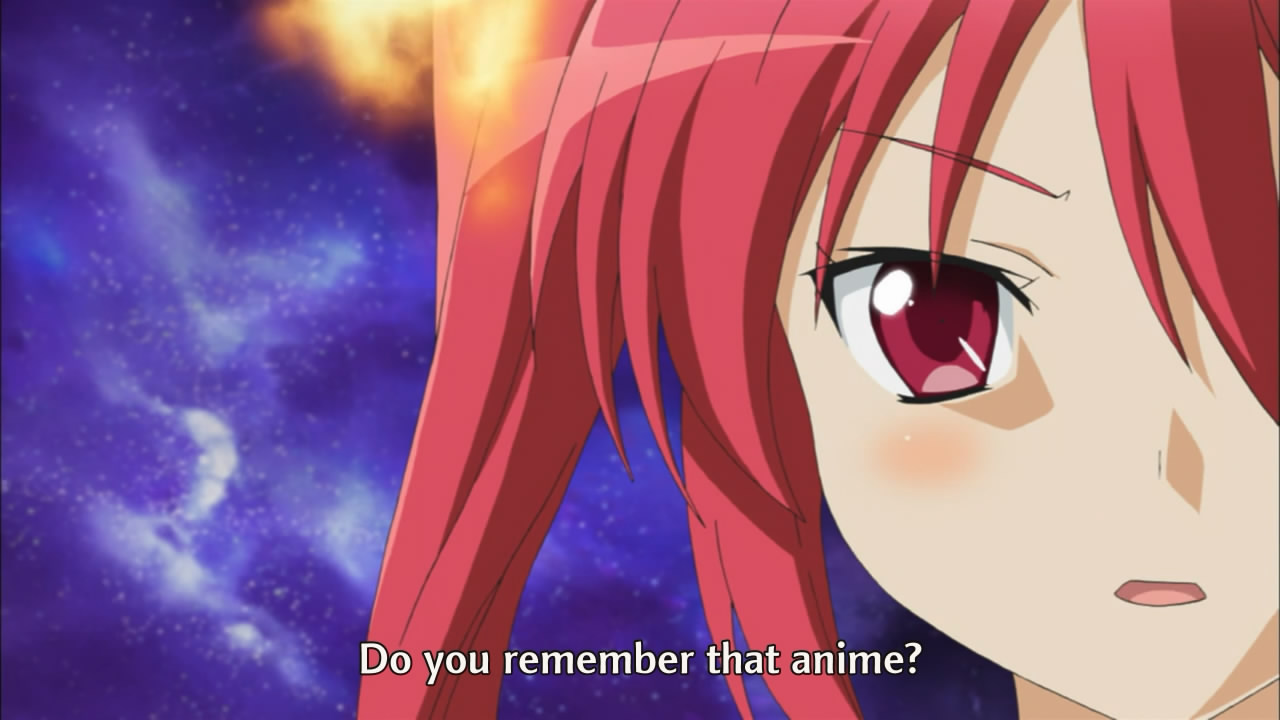Haiyore! Nyaruko-san Episode 2 References
"Take this! Space CQC Blasphemous Hand Grenade!" (1:11)
There are two references here:
* "Boutoku teki na" (冒瀆的な), "blasphemous", is a term that is frequently used in the Cthulhu Mythos.S4
* This is referencing the Holy Hand Grenade of Antioch from "Monty Python and the Holy Grail", a British movie released in 1975.S4 This is made clear on pages 155 and 156 in volume 1 of the "Haiyore! Nyaruko-san" light novel series. The original lines go as follows:
「今の、何だ」
「『冒瀆的な手榴弾』ですが」
「お前、名状しがたい~とか冒瀆的な~とか枕につけば何でもクトゥルー神話みたいに考えてないか」
「何を言っていますか真尋さん。手榴弾は由緒正しい武器なんですよ。ほら、かのアーサー王もアンティオキアで授かった聖なる手榴弾で魔物を征伐したでしょう」
「モンティ・パイソンかお前は」
"What was that just now?"
"A 'Blasphemous Hand Grenade.'"
"Are you thinking you can make anything seem Cthulhu Mythos like just by putting stuff like unspeakable or blasphemous in front of it?"
"What are you saying, Mahiro? The hand grenade is a weapon with a long and honorable history. For instance, the renowned King Arthur defeated a monster with a holy hand grenade he received at Antioch."
"Who do you think you are, Monty Python?"
"He waits dreaming." (1:54)
The Japanese line is "Yume miru mama ni machi itari" (夢見るままに待ちいたり). There are two references here:
* This is referencing a line from "The Call of Cthulhu", a short story written by H. P. Lovecraft and first published in 1928.S1 The original line is "Ph'nglui mglw'nafh Cthulhu R'lyeh wgah'nagl fhtagn", which is stated in the story to translate to "In his house at R'lyeh dead Cthulhu waits dreaming".
* This is the original title of "Haiyore! Nyaruko-san" that Aisora Manta (逢空万太) used when he submitted the story to a GA Bunko contest.S1 (Thanks convexity for translation help)
"At this moment, the stars have aligned. R'lyeh will rise to the surface." (2:12)
This is referencing R'lyeh, a sunken city where Cthulhu is imprisoned in the Cthulhu Mythos. In "The Call of Cthulhu", a short story written by H. P. Lovecraft and first published in 1928, it is stated that R'lyeh "... would rise again when the stars were right."
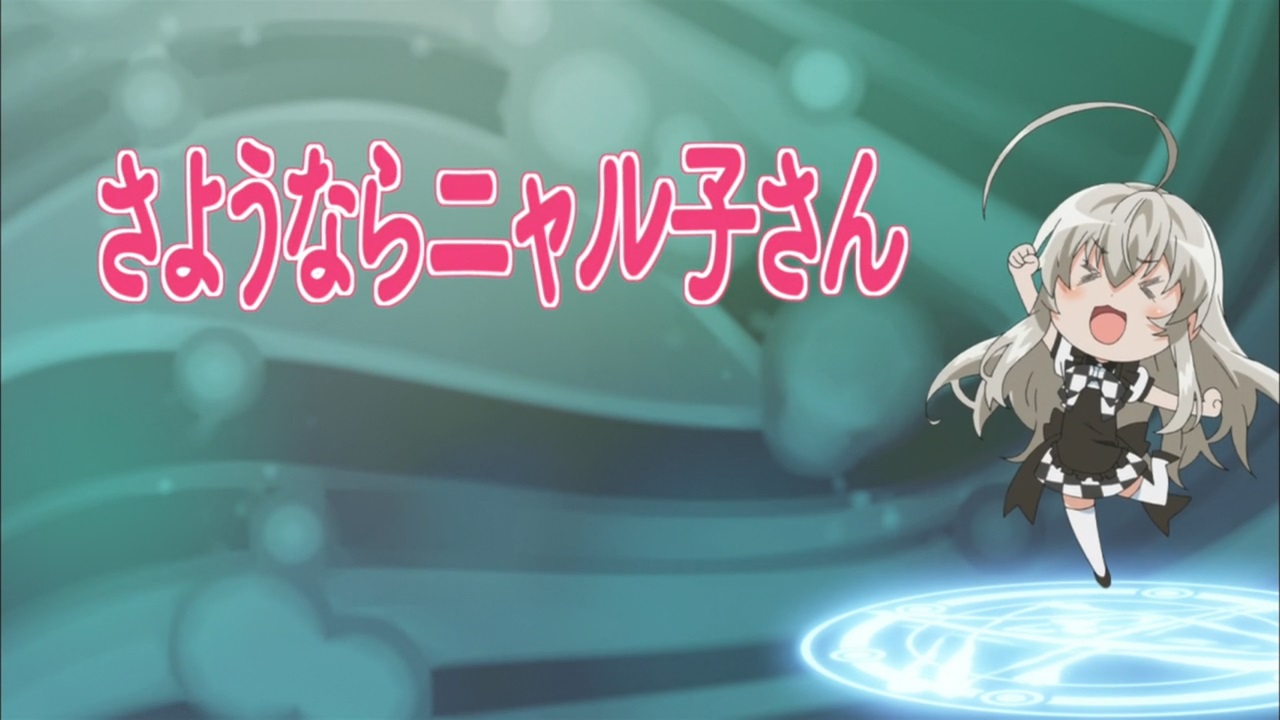
(4:11)
The title of this episode is "Sayounara Nyaruko-san" (さようならニャル子さん), which translates to "Goodbye, Nyaruko". This is referencing a chapter title from volume 6 of "Doraemon" (ドラえもん), a manga series written by Fujiko F. Fujio (藤子・F・不二雄) and published from 1969 to 1996.S4 The chapter is titled "Sayounara, Doraemon" (さようなら、ドラえもん), which translates to "Goodbye, Doraemon". Image for reference:
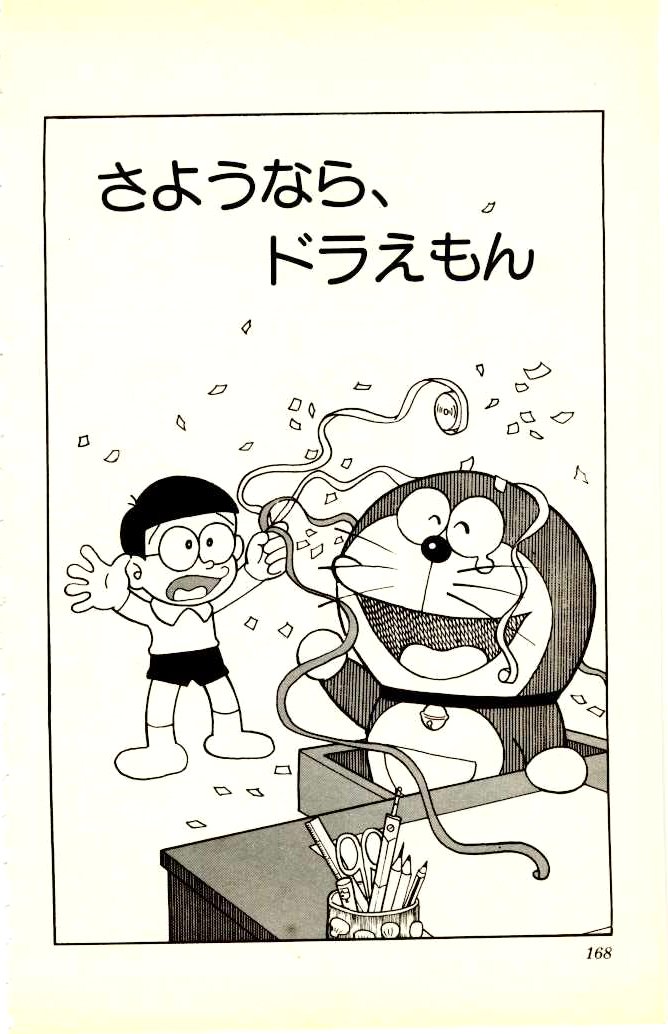
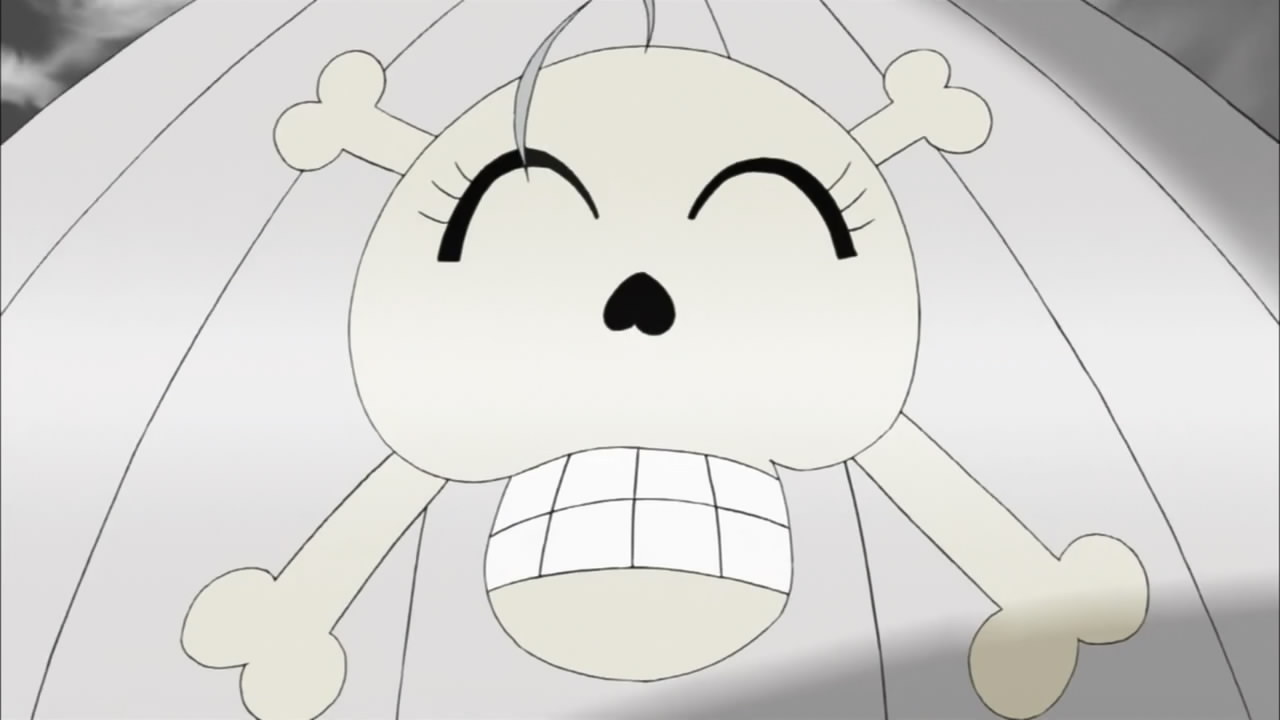
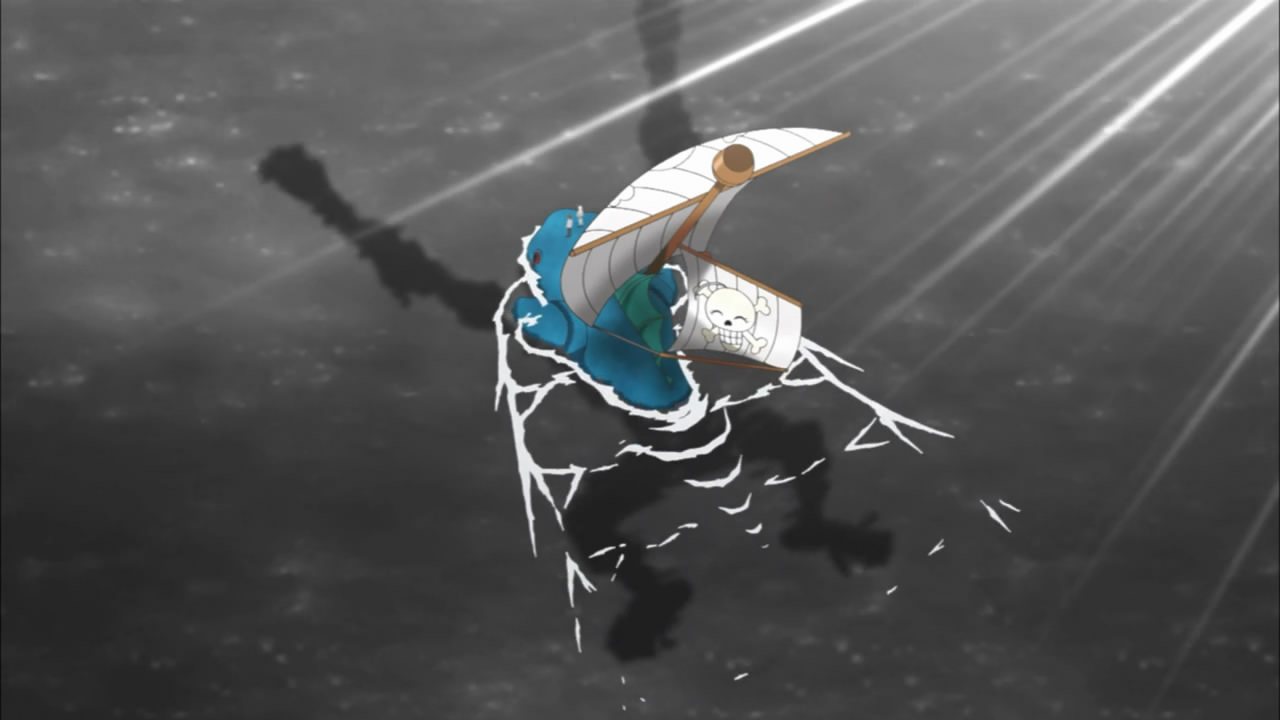
(4:18)
The mast and sails, and the skull and crossbones symbol on the sails are referencing "One Piece" (ワンピース), a manga series written by Oda Eiichirou (尾田栄一郎) and published starting from 1997. The main protagonists of the series are pirates, and they travel in a pirate ship. The symbol here is referencing the symbol used by the main protagonists. Images for reference:
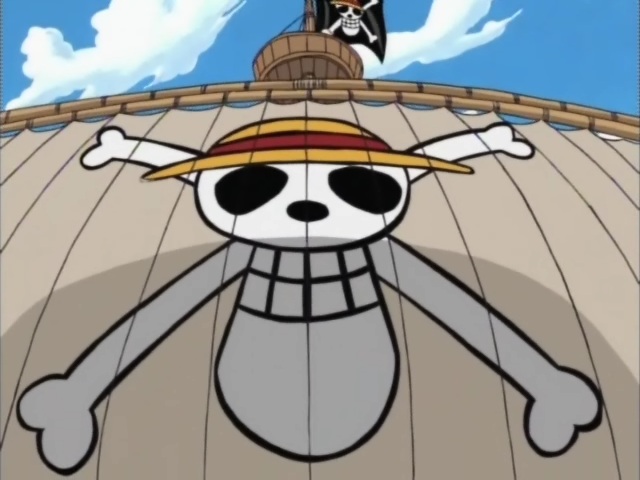
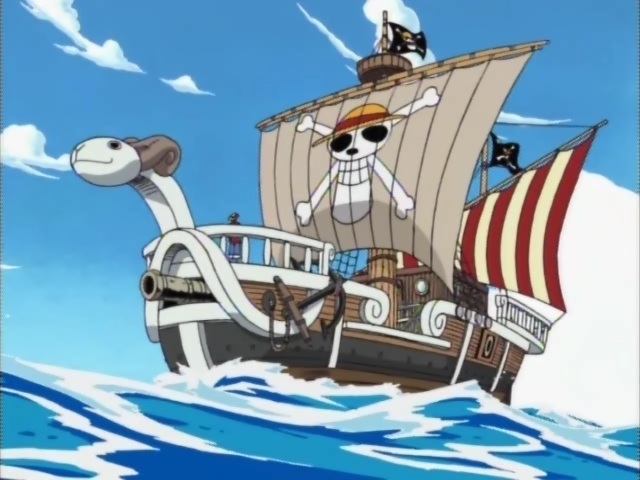
"Now let's head out towards the great ocean route!" (4:22)
"Ooinaru kouro" (大いなる航路), "great ocean route", is referencing "One Piece" (ワンピース). The main setting of the series is an ocean route referred to as "idainaru kouro" (偉大なる航路), which literally means "great ocean route" and is intended to be read as "Gurando Rain" (グランドライン), "Grand Line".
"Let's search for a bundle of treasure!" (4:25)
"Hito matomari no zaihou" (ひとまとまりの財宝), "bundle of treasure", is referencing "One Piece" (ワンピース). In the series, there exists a legendary and sought after treasure referred to as "hito tsunagi no daihihou" (ひとつなぎの大秘宝), which can mean "great bundle of treasure" and is intended to be read as "Wan Piisu" (ワンピース), "One Piece".
"Let's break into the world's greatest prison and save our imprisoned brother!" (4:28)
This line is referencing "One Piece" (ワンピース).
* "Sekai ichi no dai kangoku" (世界一の大監獄), "world's greatest prison", is referencing "Inperu Daun" (インペルダウン), "Impel Down", a prison in the series. In chapter 525 of the series, it is referred to as "sekai ichi no kaitei daikangoku" (世界一の海底大監獄), which translates to "world's greatest ocean floor prison".
* The main character, Monkey D. Luffy (モンキー・D・ルフィ), breaks into Impel Down in order to save his imprisoned brother.
"What is this fish thing, anyway?" (4:33)
The Japanese line is "Sore yori, nan da yo, kono namamono?" (それより、何だよ、このナマモノ(生物)?), which translates more literally to "In any case, what is this raw food?". This is referencing "Nangoku Shounen Papuwa-kun" (南国少年パプワくん), "Southern Boy Papuwa", a manga series written by Shibata Ami (柴田亜美) and published from 1991 to 1995. One of the characters in the series, Shintaroo (シンタロー), uses the term "Nanamono" (ナナモノ), "raw food", to describe the strange talking animal type creatures that live on Papuwa Island.S4
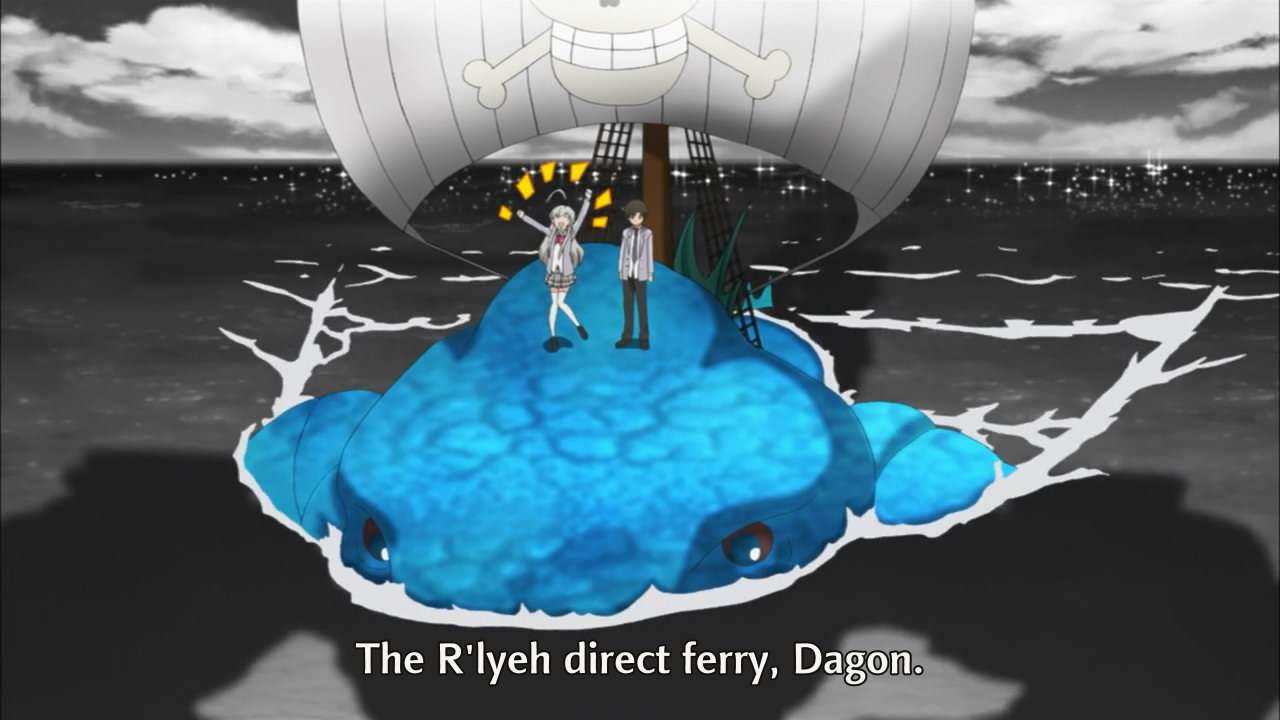

"The R'lyeh direct ferry, Dagon." (4:36)
"You have no idea how pretty his girlfriend, Hydra is!" (4:45)
Dagon and his partner, Hydra, are both enormous sea dwelling creatures that serve Cthulhu in the Cthulhu Mythos.S4 They are also known as Father Dagon and Mother Hydra, and they rule over the Deep Ones, a species of sea dwelling creature in the Mythos. In "Dagon", a short story written by H. P. Lovecraft and first published in 1919, Dagon is described as follows:
"Vast, Polyphemus-like, and loathsome, it darted like a stupendous monster of nightmares to the monolith, about which it flung its gigantic scaly arms".
"He's bellissimo cute, isn't he?" (4:40)
The Japanese line is "Berisshimo kawaii desho!" (ベリッシモ可愛いでしょ!). This is referencing a line said by Melone (メローネ) in chapter 500 in volume 54 of "Jojo no Kimyou na Bouken" (ジョジョの奇妙な冒険), "Jojo's Bizarre Adventure", a manga series written by Araki Hirohiko (荒木飛呂彦) and published starting from 1987.S4 "Berisshimo" (ベリッシモ) is the Japanese pronunciation of "bellissimo", which means "beautiful" in Italian. However Melone uses the word to mean "totemo" (とても), which means "very" or "extremely" in Japanese. In one such usage, his line goes, "Sugoku... berisshimo...... ii nenrei da" (すごく・・・ベリッシモ・・・・・・いい年齢だ), which translates to "A very... bellissimo...... good age". Image for reference:
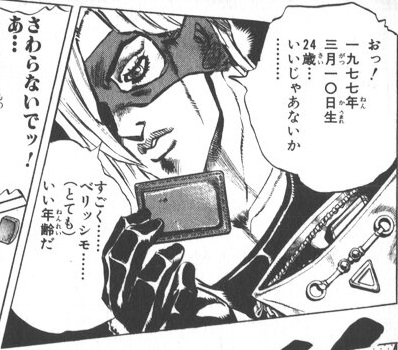

(4:59)
The symbol that appears here is based on the symbol that appears on the cover of "Necronomicon", a book written by Simon and first published in 1977. It is inspired by the Necronomicon from the Cthulhu Mythos. Image for reference:
Source of image: https://en.wikipedia.org/wiki/File:SimonNecronomicon.jpg
"You're the one who said, 'Crush the enemy base!'" (5:05)
The Japanese line is "Mahiro-san ga ittan ja nai desu ka. Teki no ajito wo buttsubusee tte" (真尋さんが言ったんじゃないですか。敵のアジトをぶっ潰せーって). The phrase "Teki no ajito wo buttsubuse" (敵のアジトをぶっつぶせ), "Crush the enemy base", is a line in the lyrics to "Raidaa Sanka" (ライダー賛歌), "Rider Anthem", a song sung by Shimon Masato (子門真人) and released in 1974. This song is used in episodes 27 and 33 of "Kamen Rider X" (仮面ライダーX), a Japanese TV show about a masked super hero that aired in 1974.S4
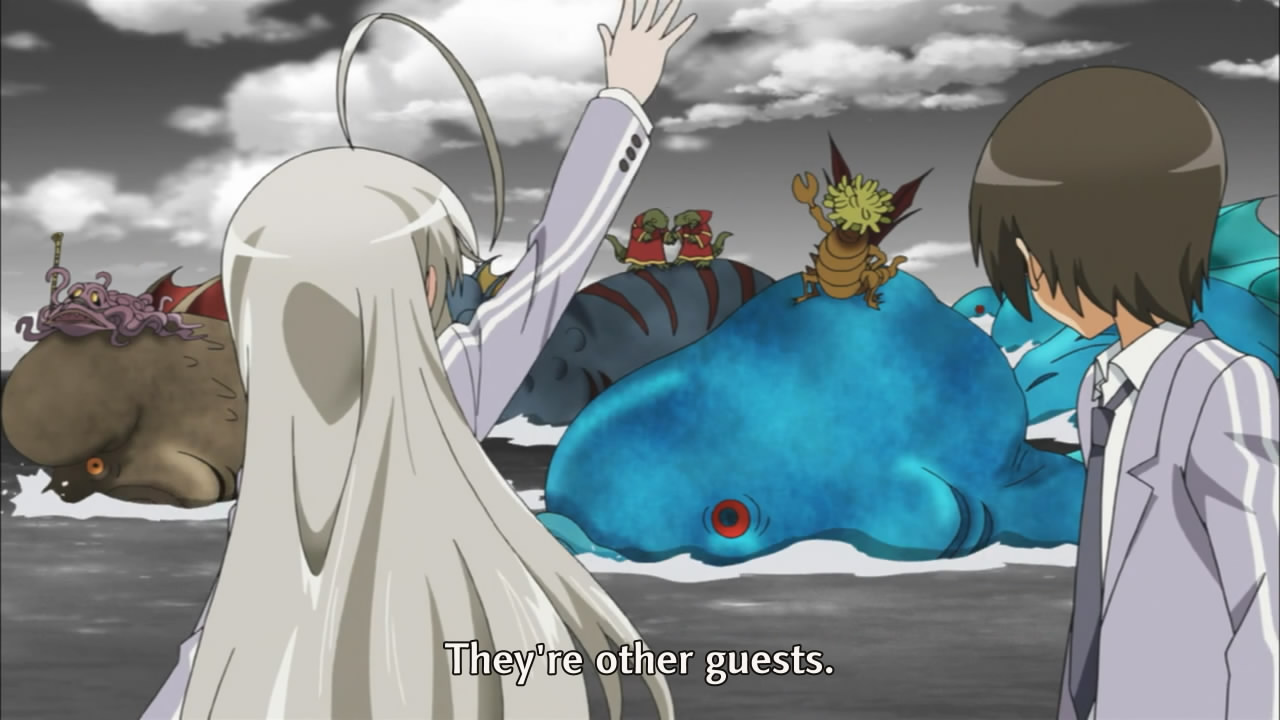
(5:25)
Nyaruko is waving at a Mi-go, a species of creature in the Cthulhu Mythos.S11 In "The Whisperer in Darkness", a short story written by H. P. Lovecraft and first published in 1931, it is described as follows:
"They were pinkish things about five feet long; with crustaceous bodies bearing vast pairs of dorsal fins or membraneous wings and several sets of articulated limbs, and with a sort of convoluted ellipsoid, covered with multitudes of very short antennae, where a head would ordinarily be."

~< `・ω・´> (5:31)
The white creature is the Twitter profile picture of Aisora Manta (逢空万太), the author of the "Haiyore! Nyaruko-san" light novel series. Screen capture for reference:

"That's the greatest theme park in the universe, the Cthulu Corporation's Earth R'lyeh Land!" (5:38)
There are two references here:
* This is referencing Cthulhu and R'lyeh where he is imprisoned.
* The names Cthulu Corporation and R'lyeh Land are referencing The Walt Disney Company and Disneyland. The Earth in Earth R'lyeh Land is a reference to the many Disneyland parks over the world, like Tokyo Disneyland and Hong Kong Disneyland.S4
"It's the third biggest roller coaster, the Madness Mountain!" (5:55)
There are two references here:
* This is referencing "At the Mountains of Madness", a story written by H. P. Lovecraft and first published in 1936.
* In line with the Disney theme, this is also a reference to Big Thunder Mountain Railroad, a roller coaster found in several Disney theme parks.S4
"The Leng Plateau Go Carts are over there!" (6:00)
This is referencing Leng, a fictional plateau in the Cthulhu Mythos.
"Miraculously, the Arkham Haunted House only has a two hour wait!" (6:02)
This is referencing Arkham House, a publishing house founded by authors August Derleth and Donald Wandrei in 1939. It specializes in publishing weird fiction and was originally founded to preserve stories written by H. P. Lovecraft in hardcover. The company's name is derived from Lovecraft's fictional town of Arkham, Massachusetts, which is featured in many of his stories.
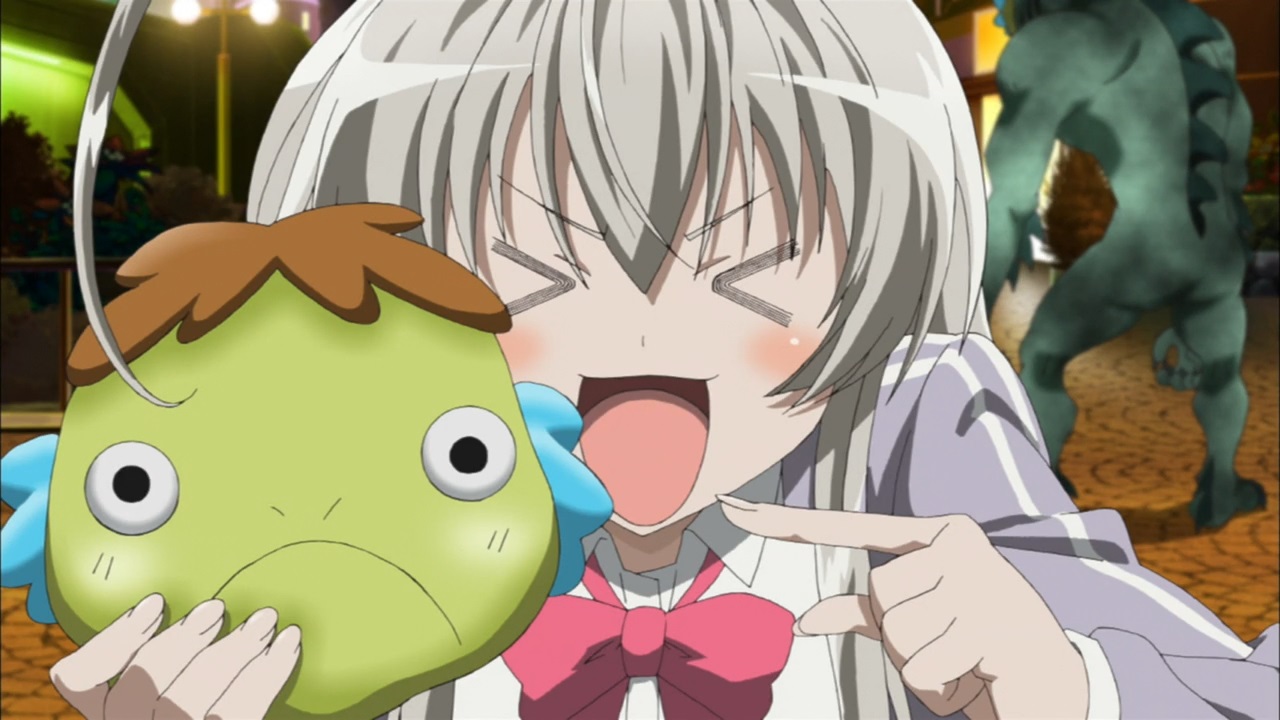
"I got this mask from the mascot, Mr. Innsmouth!" (6:10)
There are three references here:
* Innsmouth is referencing the fictional town of Innsmouth, Massachusetts from the Cthulhu Mythos, which was used in "The Shadow Over Innsmouth", a story written by H. P. Lovecraft and first published in 1936.
* Innsmouth is written as "Insumausu" (インスマウス) in Japanese. The second half of the word, "mausu" (マウス) can mean both "mouth" and "mouse". This is another Disney reference, this time to Mickey Mouse.S4
* The actual appearance of the mask is referencing the "Innsmouth Look" from the Cthulhu Mythos.S3 In "The Shadow Over Innsmouth", a story written by H. P. Lovecraft and first published in 1936, the people who live in the town of Innsmouth are described as having "queer narrow heads with flat noses and bulgy, stary eyes that never seem to shut". On a related note, the term "Innsmouth Look" is "Insumausu dura" (インスマウス面) in Japanese. The character 「面」 can actually be read as both "tsura", dura when used as a suffix, to mean "face", as well as "men" to mean "mask".S10
"Adigo!" (6:16)
Nyaruko's first yelp this episode. Adigo (アディゴ) is the name of a combat vehicle from "Space Runaway Ideon" (伝説巨神イデオン), an anime series that aired from 1980 to 1981.S8
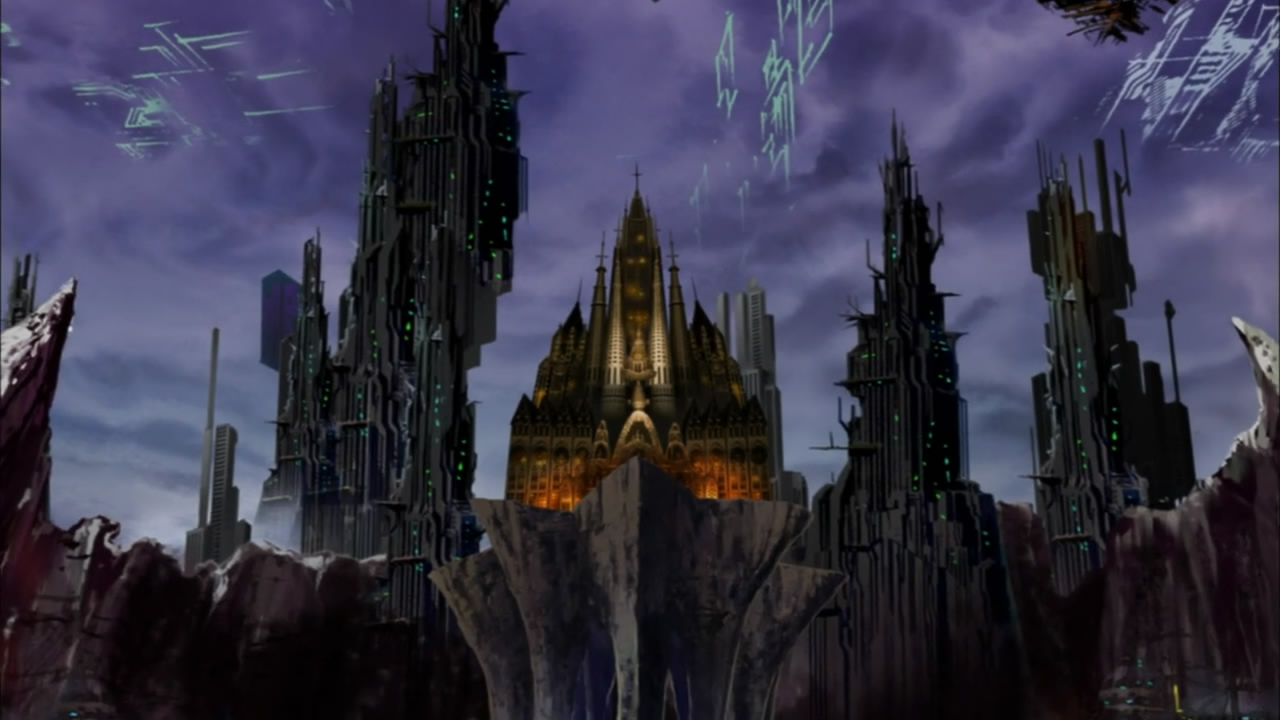

(6:30)
The auction house bears great resemblance to the Sagrada Familia, a large church in Spain. In particular, it resembles concept drawings and models of how the church would look once completed.S10 Image for reference:
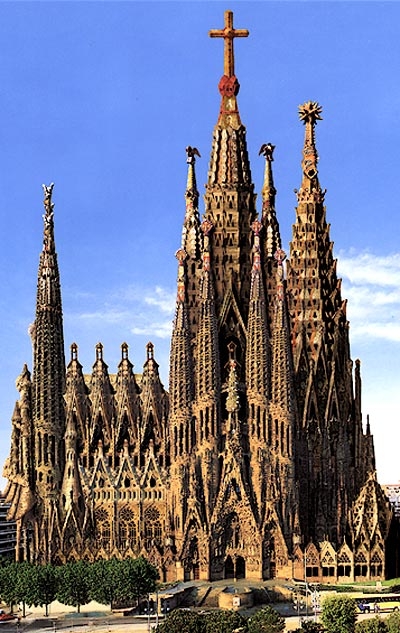
Source of image: http://www.gaudidesigner.com/uk/sagrada-familia.html
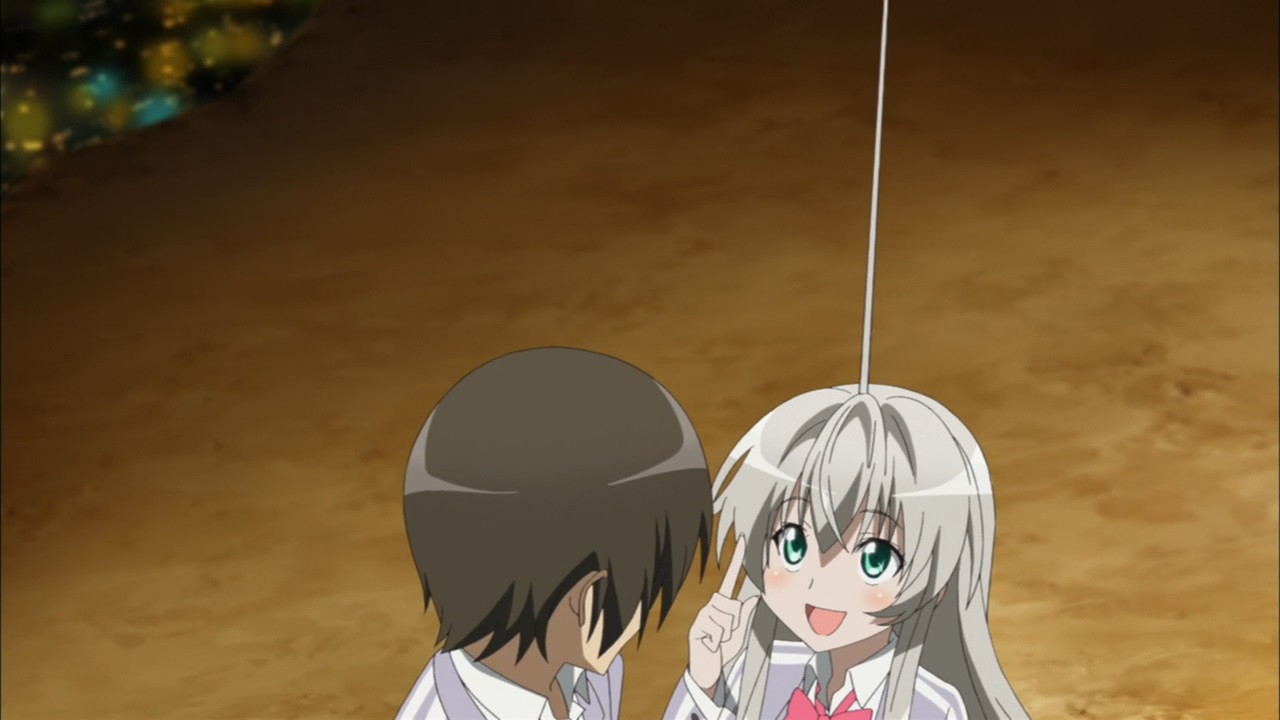
"Look, my Evil God Radar is reacting." (6:37)
Nyaruko's "Jashin Reedaa" (邪神レーダー), "Evil God Radar", is referencing Kitarou (鬼太郎) from "GeGeGe no Kitarou" (ゲゲゲの鬼太郎), a manga series written by Mizuki Shigeru (水木しげる) and first published from 1960 to 1969.S4 In the series Kitarou has an ability called "Yokai Antena" (妖怪アンテナ) that uses his hair to detect youkai or spiritual activity. When Kitarou's hair detects activity a strand of his hair sticks up.
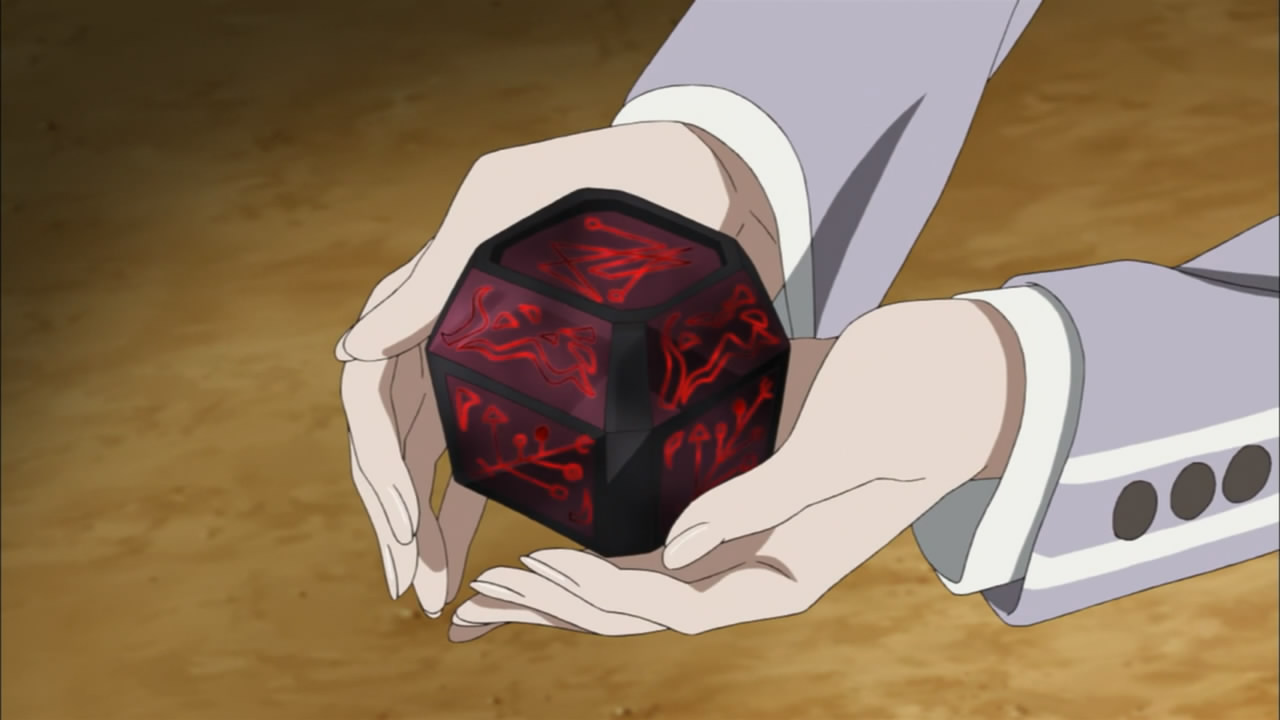
(6:47)
There are two references here:
* This is the symbol that appears on the top of the box:
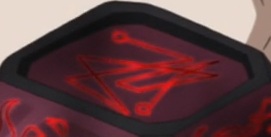
This symbol, which also appeared in episode 1 at 11:28, is based on the seal of Nyarlathotep that appears on page 105 of "Necronomicon: The Wanderings of Alhazred", a real book written by Donald Tyson and published in 2004. Image for reference:
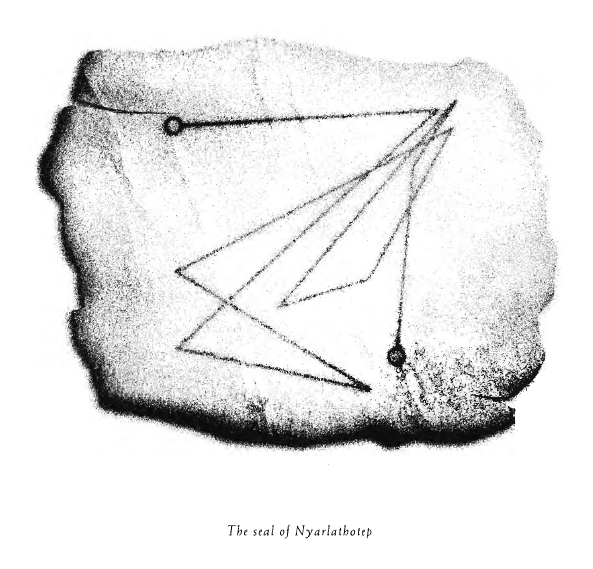
* This is the symbol that appears on the sides of the box:

This symbol is based on the great seal of the Old Ones that appears on page 116 of "Necronomicon: The Wanderings of Alhazred" by Donald Tyson.S11 Images for reference:
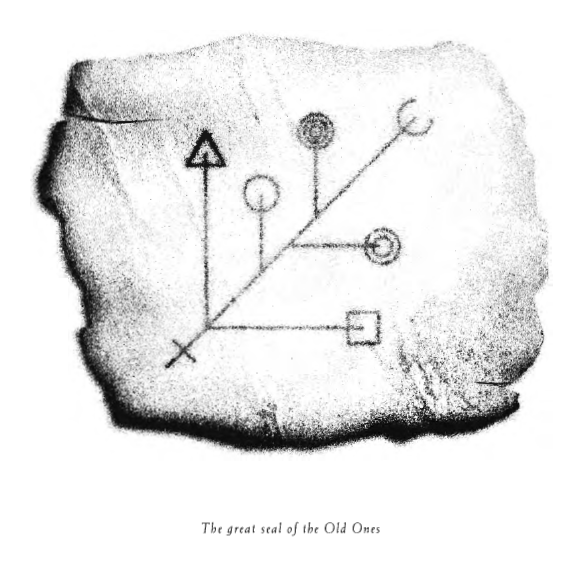
This seal is based on a Lovecraft's depiction of the Elder Sign, which he drew in a letter to Clark Ashton Smith dated November 7, 1930. Image for reference:

Source of image: https://www.hplovecraft.com/life/myths.asp#eldersign

"I knew you were behind this... Nodens." (7:55)
This character is Noodensu (ノーデンス), Nodens. He is based on Nodens, a creature classified as an Elder God in the Cthulhu Mythos who appears as an elderly man with gray hair. In "The Strange High House in the Mist", a short story written by H. P. Lovecraft and first published in 1931, Nodens is described as follows:
"... upon dolphins' backs was balanced a vast crenulate shell wherein rode the grey and awful form of primal Nodens, Lord of the Great Abyss. ... Then hoary Nodens reached forth a wizened hand and helped Olney and his host into the vast shell."Nodens has been shown to oppose Nyarlathotep in the Mythos. In "The Dream-Quest of Unknown Kadath", a story written by H. P. Lovecraft and first published in 1943, the protagonist is aided by Nodens while attempting to escape from Nyarlathotep's pursuit, which goes as follows:
"Out of the void S’ngac the violet gas had pointed the way, and archaic Nodens was bellowing his guidance from unhinted deeps. Stars swelled to dawns, and dawns burst into fountains of gold, carmine, and purple, and still the dreamer fell. Cries rent the aether as ribbons of light beat back the fiends from outside. And hoary Nodens raised a howl of triumph when Nyarlathotep, close on his quarry, stopped baffled by a glare that seared his formless hunting-horrors to grey dust. Randolph Carter had indeed descended at last the wide marmoreal flights to his marvellous city, for he was come again to the fair New England world that had wrought him."In "The Dream-Quest of Unknown Kadath", it is also stated that the Nightgaunts "bow only to potent and archaic Nodens", which relates to how Nodens was the one behind the Nightgaunts that previously attacked Mahiro.

~< `・ω・´> (8:14), (13:36)
The white creature is the Twitter profile picture of Aisora Manta (逢空万太), the author of the "Haiyore! Nyaruko-san" light novel series. In addition, in reference to this scene, Aisora Manta made a joke tweet.S4 His tweet goes as follows:
(((((~< `・ω・´> さて、真尋さんに入札してくるか……
Well, time to make my bid on Mahiro...
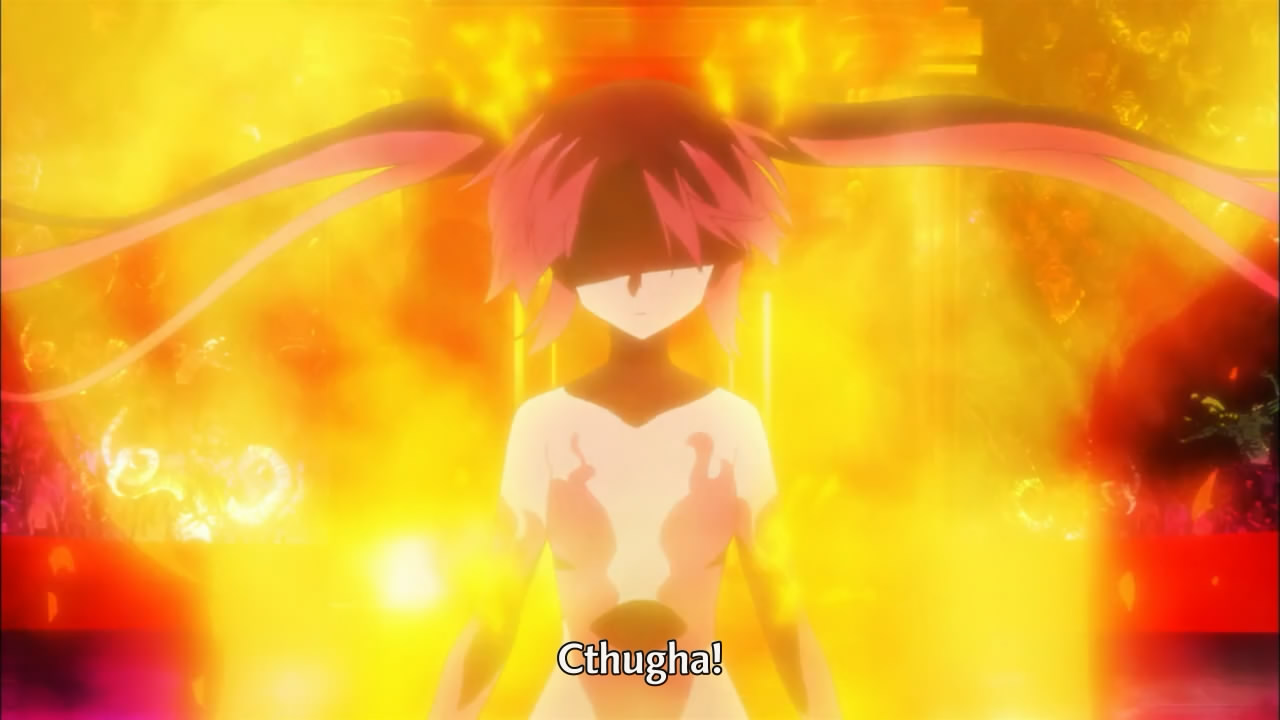
"Cthugha!" (8:46)
The character is Kuuko (クー子), Cthuko. She is based on Cthugha, a creature classified as a Great Old One in the Cthulhu Mythos.
"The arch nemesis of us Nyarlathotepians." (8:55)
Cthugha and Nyarlathotep have been established to be antagonistic towards one another in the Cthulhu Mythos. One example is in "The Dweller in Darkness", written by August Derleth and first published in 1944. In the story there is a large forest in north central Wisconsin that exudes a sinister aura. Due to various mysterious deaths and disappearances relating to it, a man known as Professor Gardner decides to investigate. However, he vanishes, as well. The protagonists, Jack, the narrator, and Laird Dorgan, his companion, step in to try to find out what happened. As the story progresses they learn that an avatar of Nyarlathotep, the Dweller in Darkness, is inhabiting the forest and causing the incidents. Finally Gardner conveys the two a message. Quoted from the story,
"Listen to me! Leave this place. Forget. But before you go, summon Cthugha. For centuries this has been the place where evil beings from outermost cosmos have touched upon Earth. ... It is His wood—the Wood of N'gai, the terrestrial abode of the Blind, Faceless One, the Howler in the Night, the Dweller in Darkness, Nyarlathotep, who fears only Cthugha. ... When Fomalhaut has topped the trees, call forth to Cthugha in these words, thrice repeated: Ph'nglui mglw'nafh Cthugha Fomalhaut n'gha-ghaa naf'l thagn! Iä! Cthugha! When He has come, go swiftly, lest you too be destroyed. For it is fitting that this accursed spot be blasted so that Nyarlathotep comes no more out of interstellar space."The two successfully summon Cthugha and flee as it sets forth to annihilate the forest and everything within it.
"Nodens Dimension, where my enemy's strength is doubled and mine is halved..." (10:12)
"Noodensu Jikuu" (ノーデンス時空), "Nodens Dimension", is referencing "Uchuu Keiji Shaidaa" (宇宙刑事シャイダー), "Space Sheriff Shaider", a Japanese TV series that aired from 1984 to 1985.S3 In the series there exists an alternate dimension called "Fushigi Jikuu" (不思議時空), "Mysterious Dimension", in which the main character's enemies are four times more powerful than they are in the normal world.
"My Space CQC Part 5!" (10:39)
The Japanese line is "Watashi no Uchuu Shii Kyuu Shii Paato Faibu!" (私の宇宙CQCパート5!). This is referencing a line said by Momotarosu (モモタロス) in episode 18 of "Kamen Rider Den-O" (仮面ライダー電王), a Japanese TV show about a masked super hero that aired from 2007 to 2008.S6 The original line is, "Ore no Hissatsu Waza Paato faibu!" (俺の必殺技パート5!), which translates to "My Certain Kill Technique Part 5!". In addition, Nyaruko skipping from part 2 to part 5 is also referencing how prior to episode 18, the last attack Momotarosu names is named "Ore no Hissatsu Waza Paato Surii" (俺の必殺技パート3), which translates to "My Certain Kill Technique Part 3". When this is brought to his attention, Momotarosu states, "Ikko tobasu kurai sugeen da yo!" (1個飛ばすくらいすげぇんだよ!), which translates to "It's so awesome that it skipped a number!".

"My Space CQC, Type 100." (10:54)
There are two references here:
* Cthuko's flying weapons that shoot lasers are based on funnels, remote controlled flying weapons that appear in various shows in the "Gundam" series. Video for reference: https://youtu.be/_bTvXsXvOMY?t=30s
* "Hyakushiki" (百式), "Type 100", is the name of a combat vehicle that appears in "Mobile Suit Zeta Gundam" (機動戦士Ζガンダム), an anime series that aired from 1985 to 1986.S5
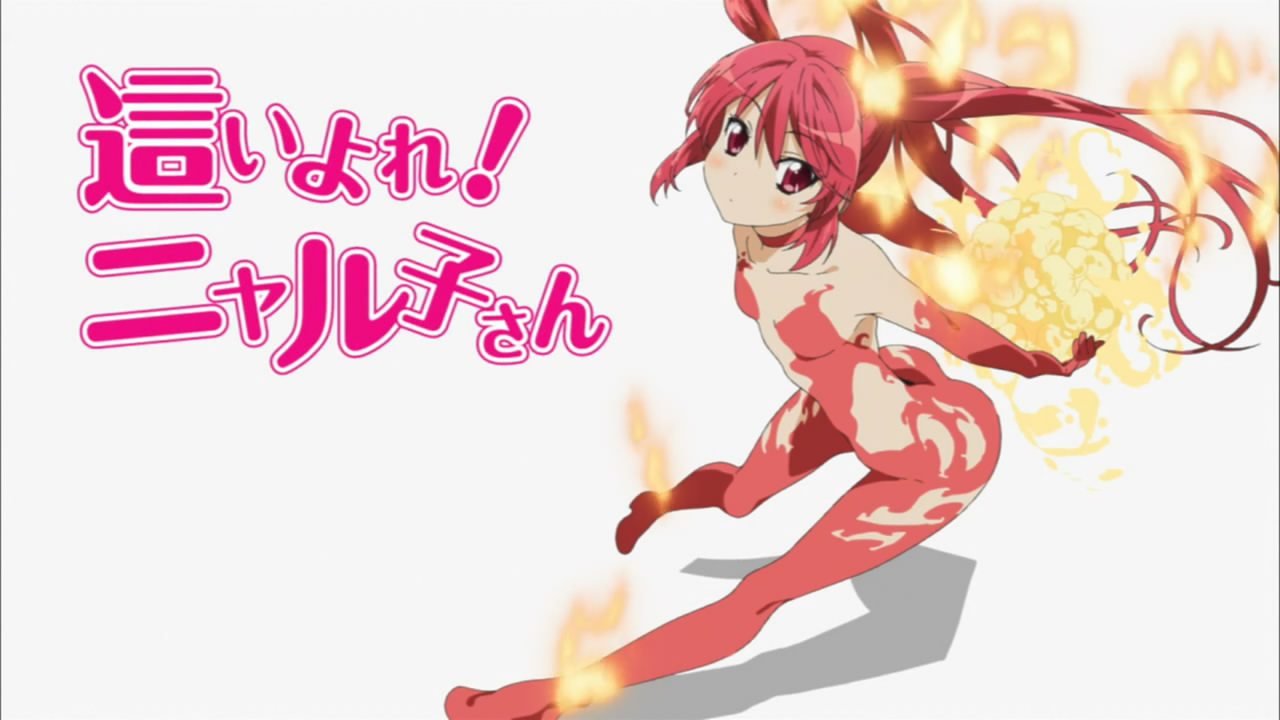
(11:10)
The ball of fire Cthuko is holding is referencing Cthugha's appearance in the Cthulhu Mythos. In "The Dweller in Darkness", a short story written by August Derleth, Cthugha is described as a "great being hovering like a cloud of living fire". In particular, the appearance Cthugha here seems to be based on a depiction that appears in "Kyoufu to Kyouki no Kutourufu Shinwa" (恐怖と狂気のクトゥルフ神話), "Terrifying and Insane Cthulhu Mythos", a Japanese visual guide book to the Cthulhu Mythos released in 2009. Image for reference:
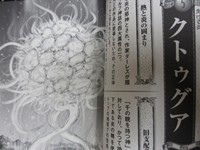
Source of image: http://d.hatena.ne.jp/servitors/20130410/p1
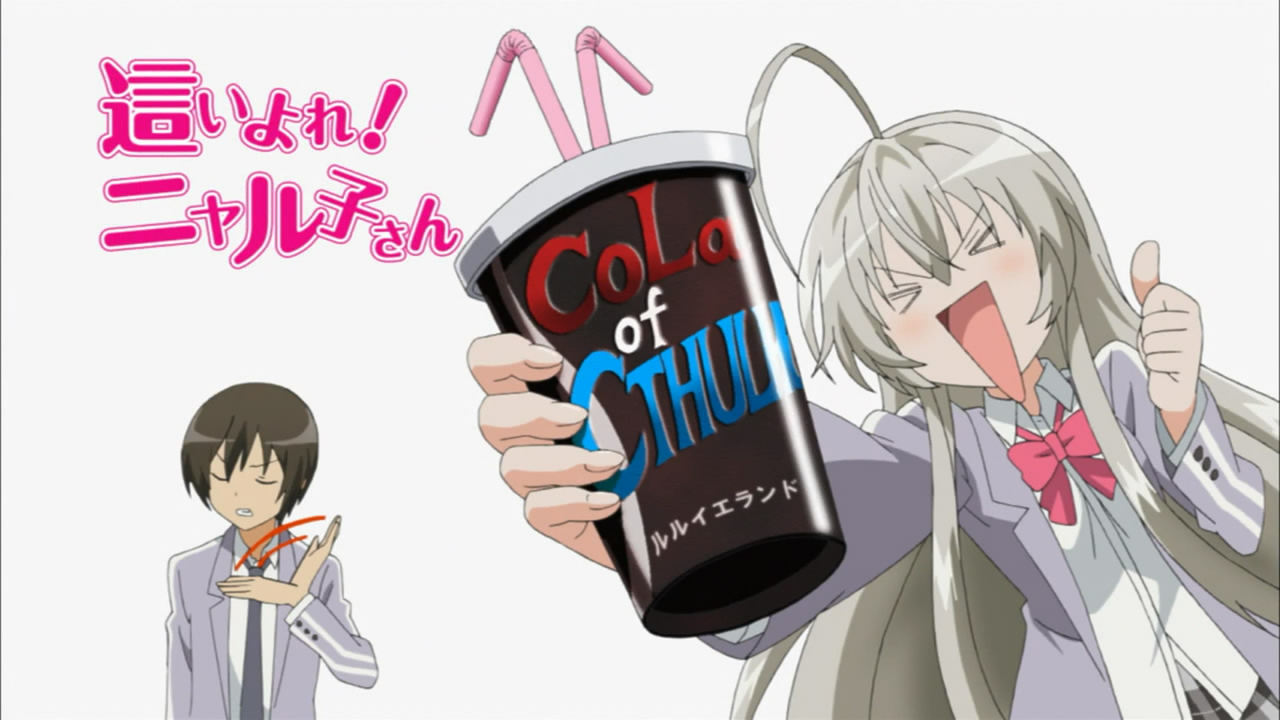
Cola of Cthulhu (11:15)
This is a pun on "The Call of Cthulhu", the title of a short story written by H. P. Lovecraft and first published in 1928.S1 In Japanese, "Call of Cthulhu" is written as 「コール・オブ・クトゥルフ」, "Kooru Obu Kuturufu", while "Cola" is written as 「コーラ」, "Koora".
"Nyaruko, you are like a super dimensional circus." (11:36)
There are two references here:
* "Chou jikuu teki" (超時空的), "super dimensional", is referencing "Chou Jikuu Yousai Makurosu" (超時空要塞マクロス), "Super Dimensional Fortress Macross", an anime series that aired from 1982 to 1983.
* "Circus" is referencing the "Itano Circus" (板野サーカス), a term used to describe scenes in which extreme numbers of projectiles are fired and said projectiles typically chase after targets in brilliant displays of animation. This term is named after Itano Ichirou (板野一郎), a famous anime director and animator who pioneered this style of animation and worked on many notable series including "Super Dimensional Fortress Macross". Here is a video containing many examples of Itano Circus styled scenes for reference: https://youtube.com/watch?v=BzXfVgYCxWI Also, here's a blog post about the subject: http://ghostlightning.wordpress.com/2009/04/15/itanocircus/
"Do you remember love?" (11:41)
The Japanese line is "Ai oboeteimasu ka?" (愛おぼえていますか?). This is referencing a song by that title made famous when it was used as the theme song for "Chou Jikuu Yousai Makurosu Ai Oboeteimasu ka" (超時空要塞マクロス 愛・おぼえていますか), "The Super Dimension Fortress Macross: Do You Remember Love?", a movie released in 1984.
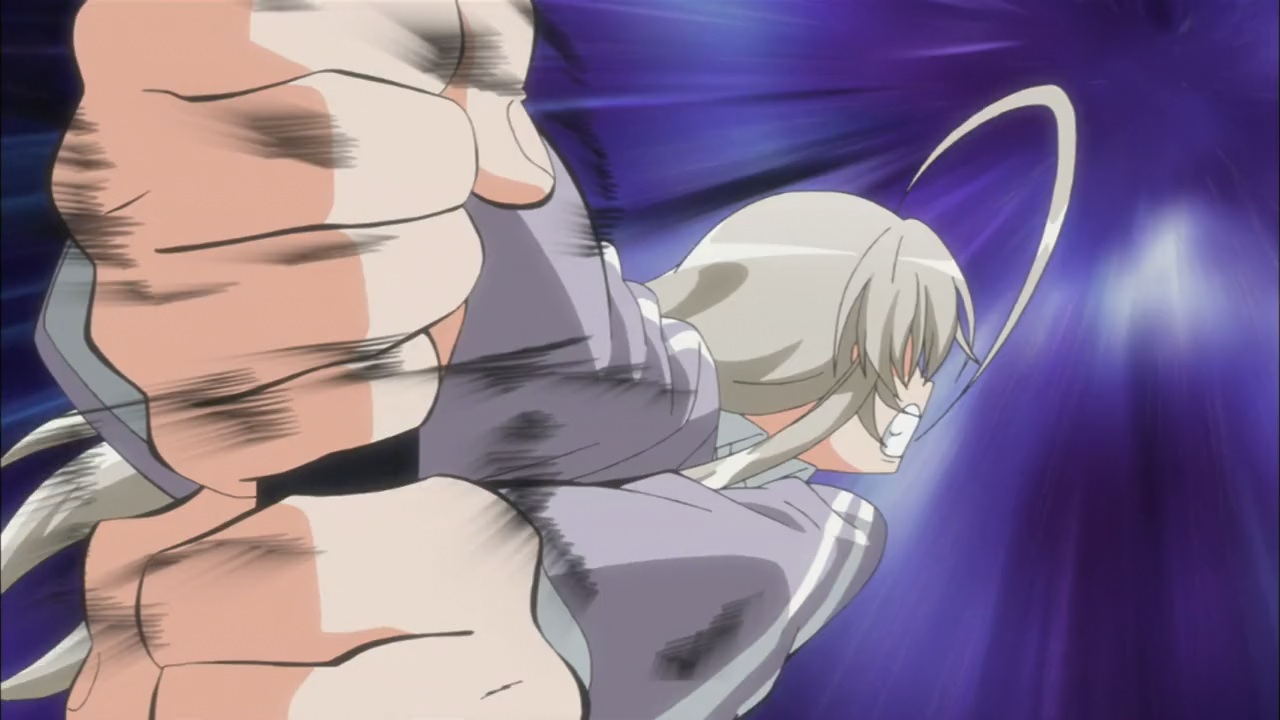
(11:48)
This scene is referencing Hanagata Mitsuru from "Kyojin no Hoshi" (巨人の星), "Star of Giants", a manga series written by Kajiwara Ikki (梶原一騎) and published from 1966 to 1971. Nyaruko's swinging form is referencing that of Hanagata Mitsuru (花形満) when he is able to successfully hit back a pitch from Hoshi Hyuuma (星飛雄馬) who used his special pitching technique, "Dai Riigu Booru Ichigou" (大リーグボール1号), "Major League Ball #1".S1 In the anime adaptation, this event occurs in episode 83. Images for reference:

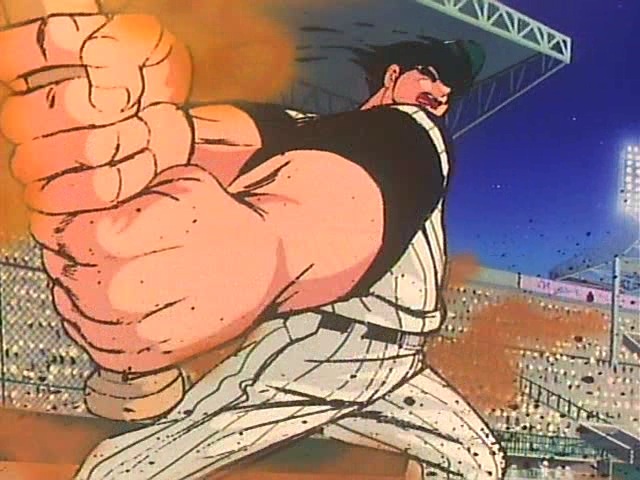
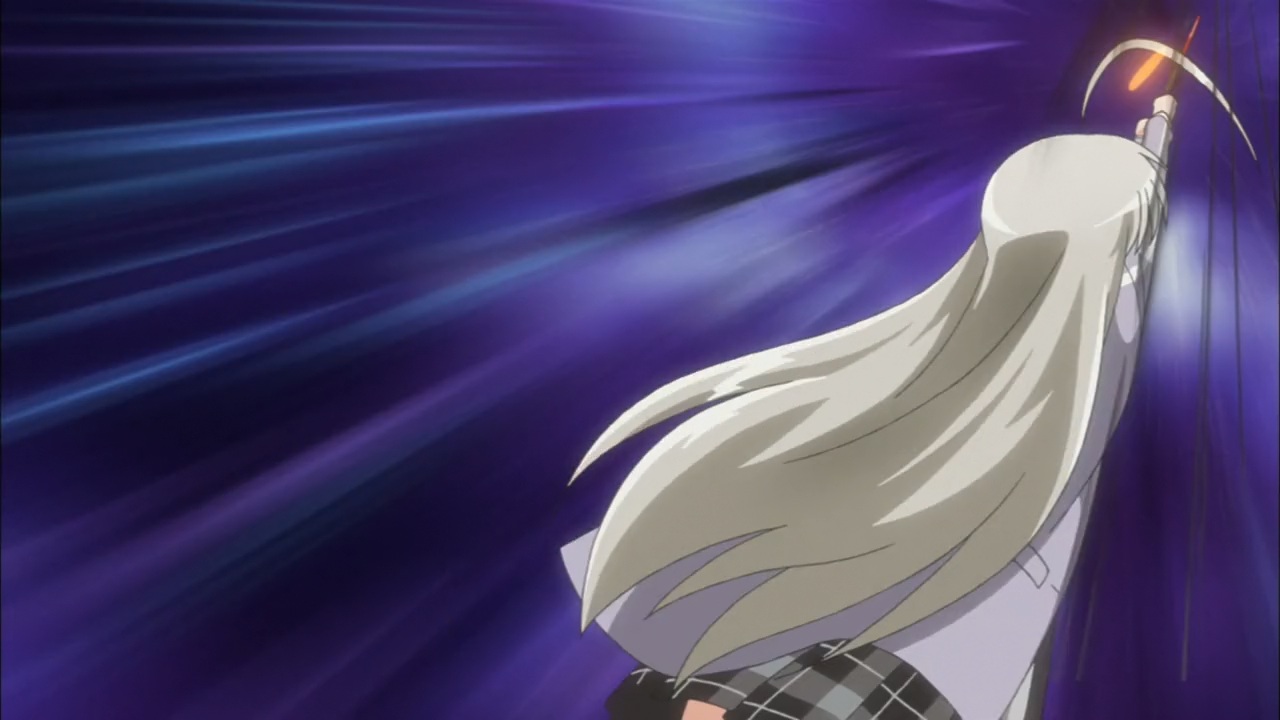
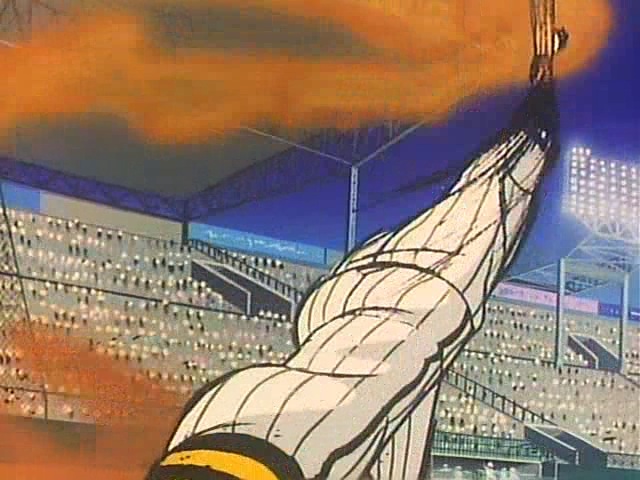
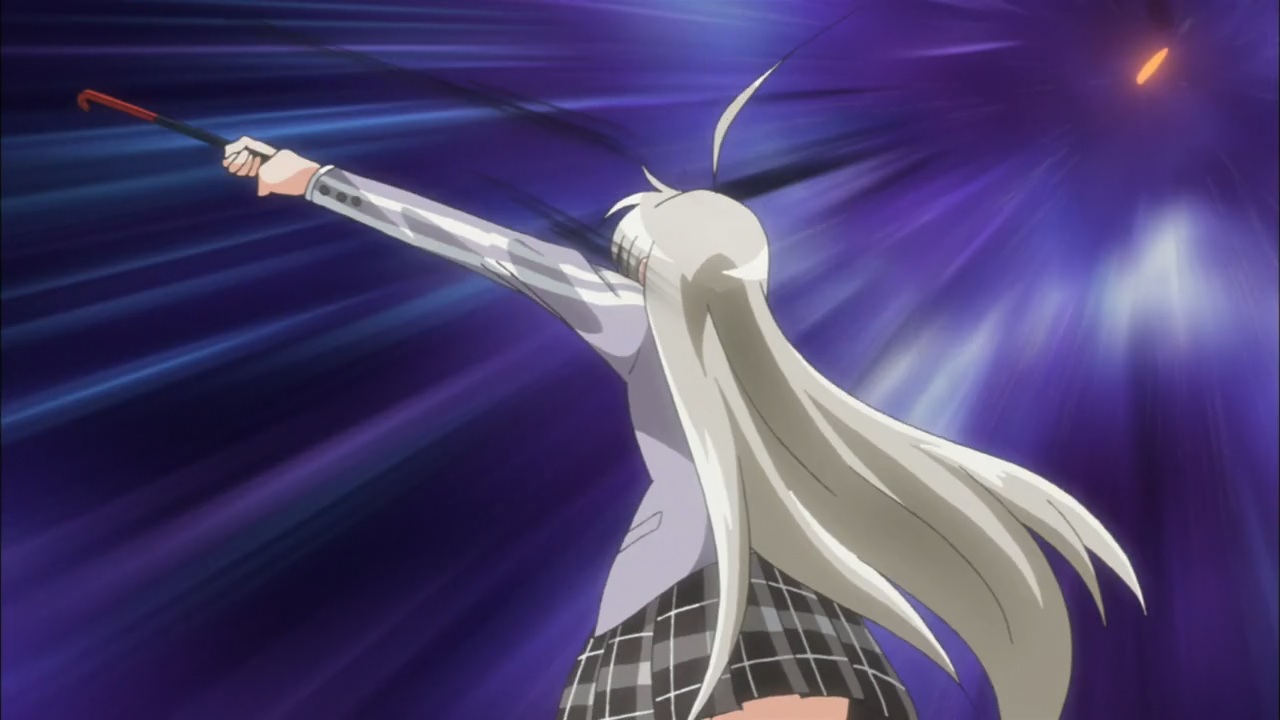

(11:51)
At this time Nyaruko repeatedly shouts "Ora" (オラ). This word doesn't have any specific meaning, it's just a sound made when exerting effort. This is referencing the word repeatedly shouted by Star Platinum (スタープラチナ) when he attacks in "Jojo no Kimyou na Bouken" (ジョジョの奇妙な冒険), "Jojo's Bizarre Adventure", a manga series written by Araki Hirohiko (荒木飛呂彦) and published starting from 1987. Image for reference:
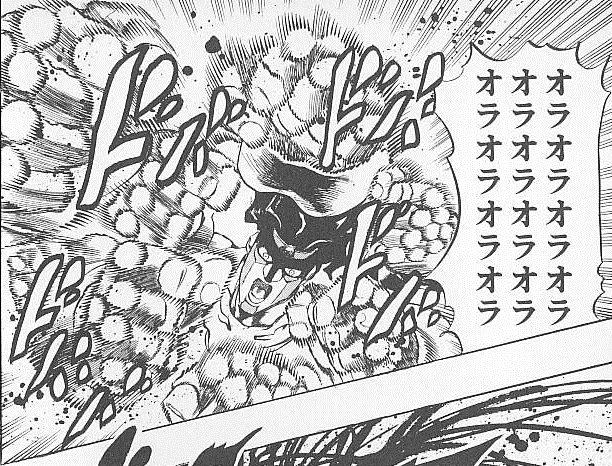
"People grow every day." (12:08)
The Japanese line is "Hito ha hibi seichou suru mono da kara" (人は日々成長するものだから). This is referencing a line said by Geese Howard in "Garou Densetsu" (餓狼伝説), a manga series written by Hosoi Yuji (細井雄二) and published in Komikku Bon Bon (コミックボンボン) from 1993 to 1996. It is also referred to as "Bon Bon Garou" (ボンボン餓狼). The manga is a spin-off of Fatal Fury, a 2D fighting game series.S2 When Terry, the protagonist, confronts Geese for a final battle, Geese says,
「だが人は日々成長するんだよ・・・・このわたしがいつまでも同じところにとどまっているとおもうのはまちがいだ」Image for reference:
"Daga hito ha hibi seichou suru n da yo.... Kono watashi ga itsu made mo onaji tokoro ni todomatteiru to omou no ha machigai da"
"However, people grow every day.... Thinking that I've stayed the same all this time is a mistake"

Source of image: http://bohyou.vis.ne.jp/neogeo/bongaro/bongaro1_f.htm
"Citizen Bright Publication, 'Our Space CQC is Amazing!'" (12:18)
The Japanese line uses the phrase "Shichizun Buraito" (シチズンブライト), "Citizen Bright". If these words are interpreted into Japanese, the Japanese characters for "citizen" and "bright" are 「民」 and 「明」. When combined they form the word 「民明」, which can be read as "Minmei". This is referencing Minmei Publishing Company (民明書房) from "Sakigake!! Otokojuku" (魁!!男塾), "Charge!! Manly Academy", a manga series written by Miyashita Akira (宮下あきら) and published from 1985 to 1991.S4
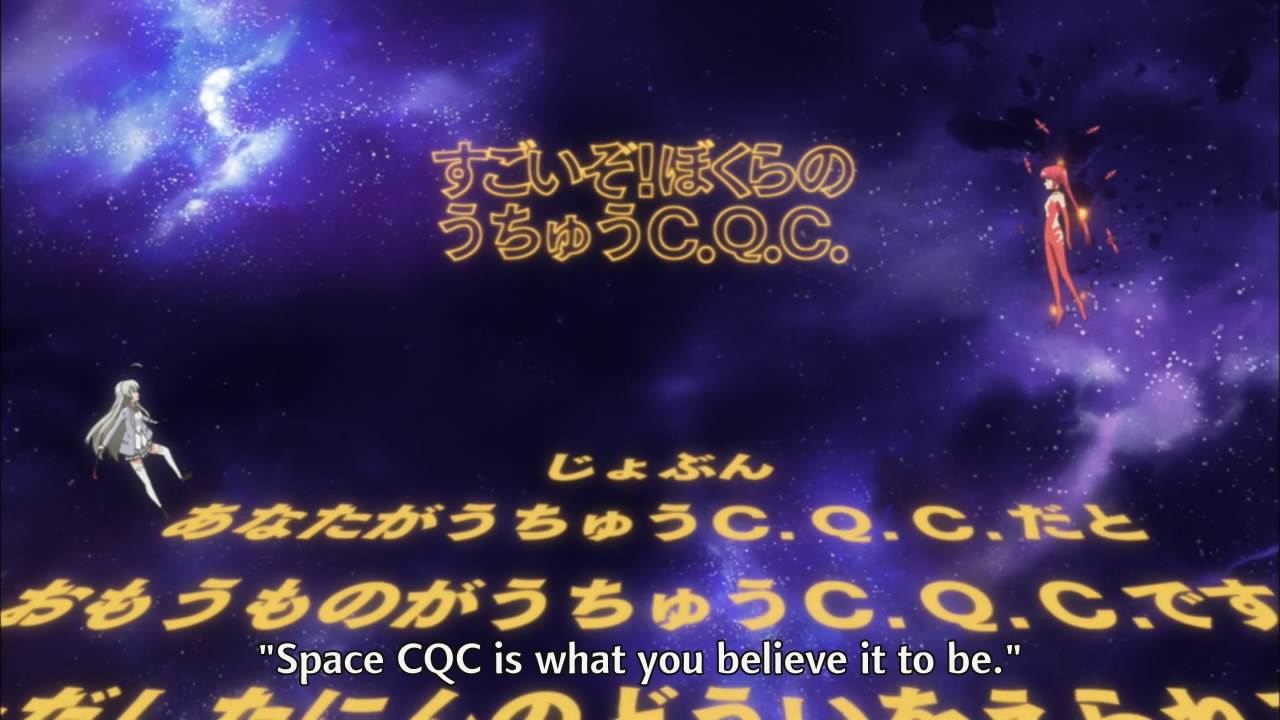
(12:26)
There are two references here:
* The scrolling yellow text is referencing the opening crawl from the "Star Wars" movie series. Image for reference:
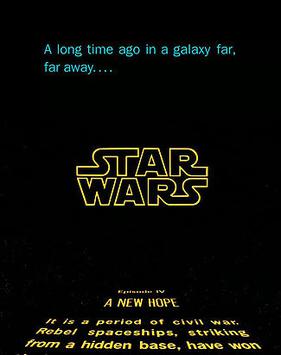
* The line at this time goes as follows:
「あなたがうちゅうC.Q.C.だとおもうものがうちゅうC.Q.C.です。ただしたにんのどういをえられるとはかぎりません・・・・・・」This line is referencing the rules of the light novel board on 2ch.S9 They go as follows:
"Anata ga uchuu C.Q.C. da to omou mono ga uchuu CQC desu. Tadashi tanin no doui wo erareru to ha kagirimasen......"
"Space CQC is what you believe it to be. However, others may not agree with you."
「ライトノベルの定義」。あなたがそうだと思うものがライトノベルです。ただし、他人の同意を得られるとは限りません。Image for reference:
"Raito Noberu no Teigi". Anata ga sou da to omou mono ga raito noberu desu. Tadashi, tanin no doui wo erareru to ha kagirimasen.
"Definition of light novels". Light novels are what you think they are. However, others may not agree with you.
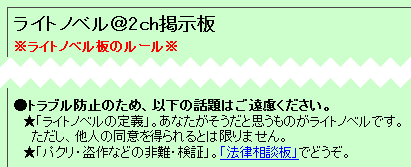
"What is this?" (12:50)
The Japanese line is "N,Nanja koryaa!?" (な、なんじゃこりゃあ!?). This is a reference to the same line said by Detective Shibata Jun when he is killed in the line of duty in episode 111 of "Taiyou ni Hoero!" (太陽に吠えろ!), "Bark at the Sun!", a Japanese television drama that aired from 1972 to 1987.S4
"No, that reasoning makes no sense." (14:02)
The Japanese line is "Iya, sono rikutsu ha okashii" (いや、そのりくつはおかしい). This is referencing the same line said by Doraemon in volume 6 of "Doraemon" (ドラえもん), a manga series written by Fujiko F. Fujio (藤子・F・不二雄) and published from 1969 to 1996.S3 Image for reference:

(14:13)
There are two references here.
* The line at this time goes as follows:
「おじいさんが言ってた、ニャルラトホテプを愛するクトゥグアがいてもいい。自由とはそういうものだ。」This referencing to a line said by Roger Smith in episode 13 of "The Big O" (THEビッグオー), an anime series that aired from 1999 to 2000.S5 His line goes as follows:
"Ojii-san ga itteta, Nyaruratohotepu wo aisuru Kutugua ga ite mo ii. Jiyuu ha sou iu mono da."
"Grandfather once said, 'A Cthugha may love a Nyarlathotep. That's what it means to live free.'"
「雨の中、傘をささずに踊る人間がいてもいい。自由とはそういうことだ。」On a related note, the main writer of "The Big O", Konaka Chiaki (小中千昭), is also a Cthulhu Mythos writer and tends to add Mythos inspired elements to his works. For example, a Mythos inspired robot called Dagon (ダゴン) appears in episode 7 of "The Big O".S3
"Ame no naka, kasa wo sasazu ni odoru ningen ga ite mo ii. Jiyuu to ha sou iu koto da."
"Some people like to stand in the rain without an umbrella. That's what it means to live free." (English dub)
* The phrase "Ojii-san ga itteta" (おじいさんが言ってた), "Grandfather once said", is referencing a similar line said by Tendou Souji (天道総司) in "Kamen Rider Kabuto" (仮面ライダーカブト), a Japanese TV show about a masked super hero that aired from 2006 to 2007. His line goes "Obaa-chan ha itteta" (おばあちゃんは言ってた), which translates to "Grandmother once said".S6
"Is that old man a negotiator in the City of Amnesia?" (14:20)
The Japanese line is "Kioku nakushita machi no negoshieitaa ka, sono jijii!" (記憶なくした街のネゴシエイターか、そのジジイ!). This is referencing the character Roger Smith from "The Big O", who is a negotiator in the City of Amnesia.
"Ye not guilty." (14:23)
The Japanese line is "Nanjira tsumi nashi" (汝ら罪なし). This is another reference to "The Big O". The first line in the first episode of "The Big O" goes as follows:
神の名においてこれを鋳造する。汝ら罪なしImages for reference:
Kami no na ni oite kore wo chuuzou suru. Nanjira tsumi nashi
CAST IN THE NAME OF GOD YE NOT GUILTY

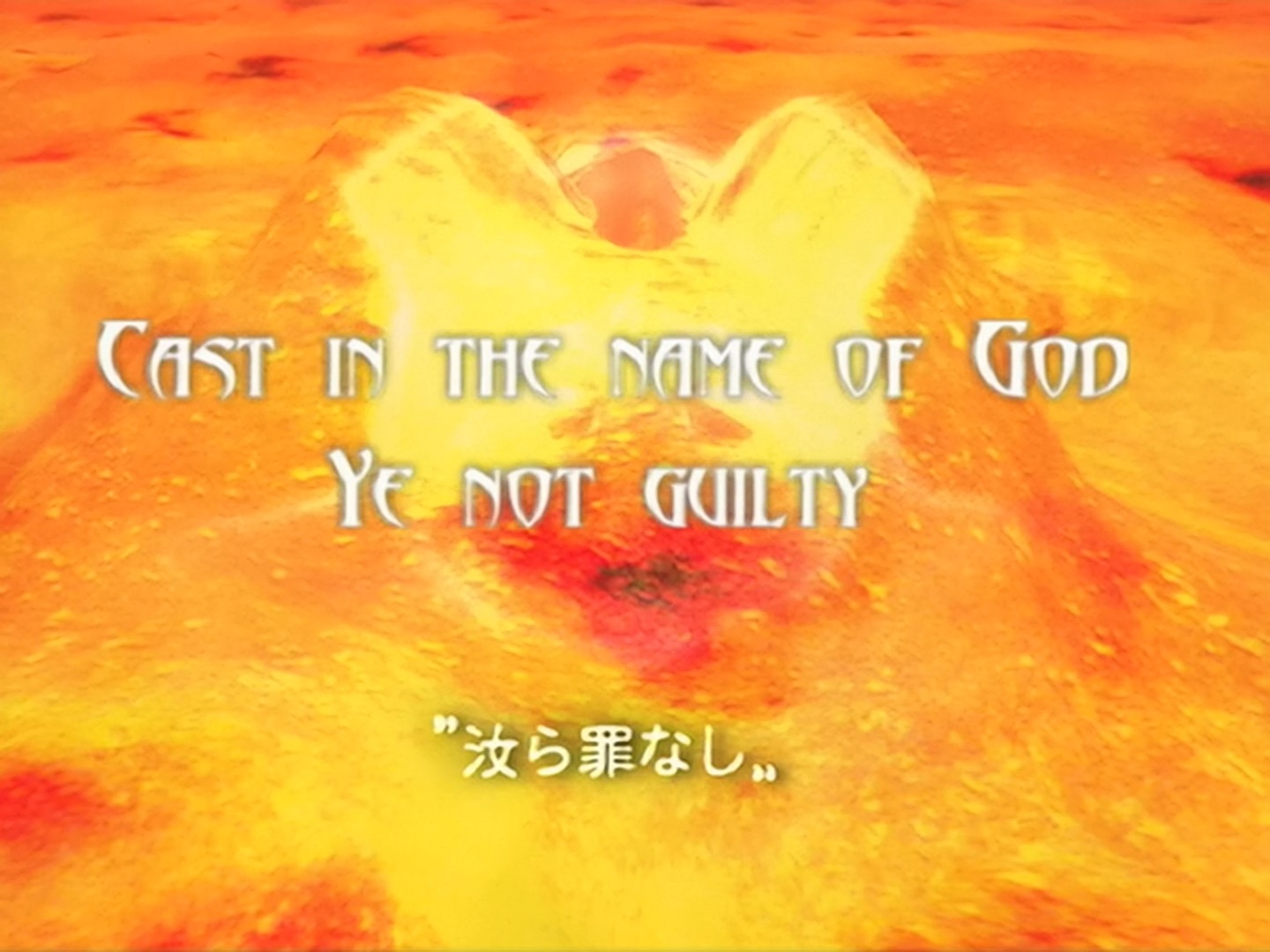
In addition, this text appears on the display panel in the cockpit of Big O, a giant robot piloted by Roger Smith. Images for reference:


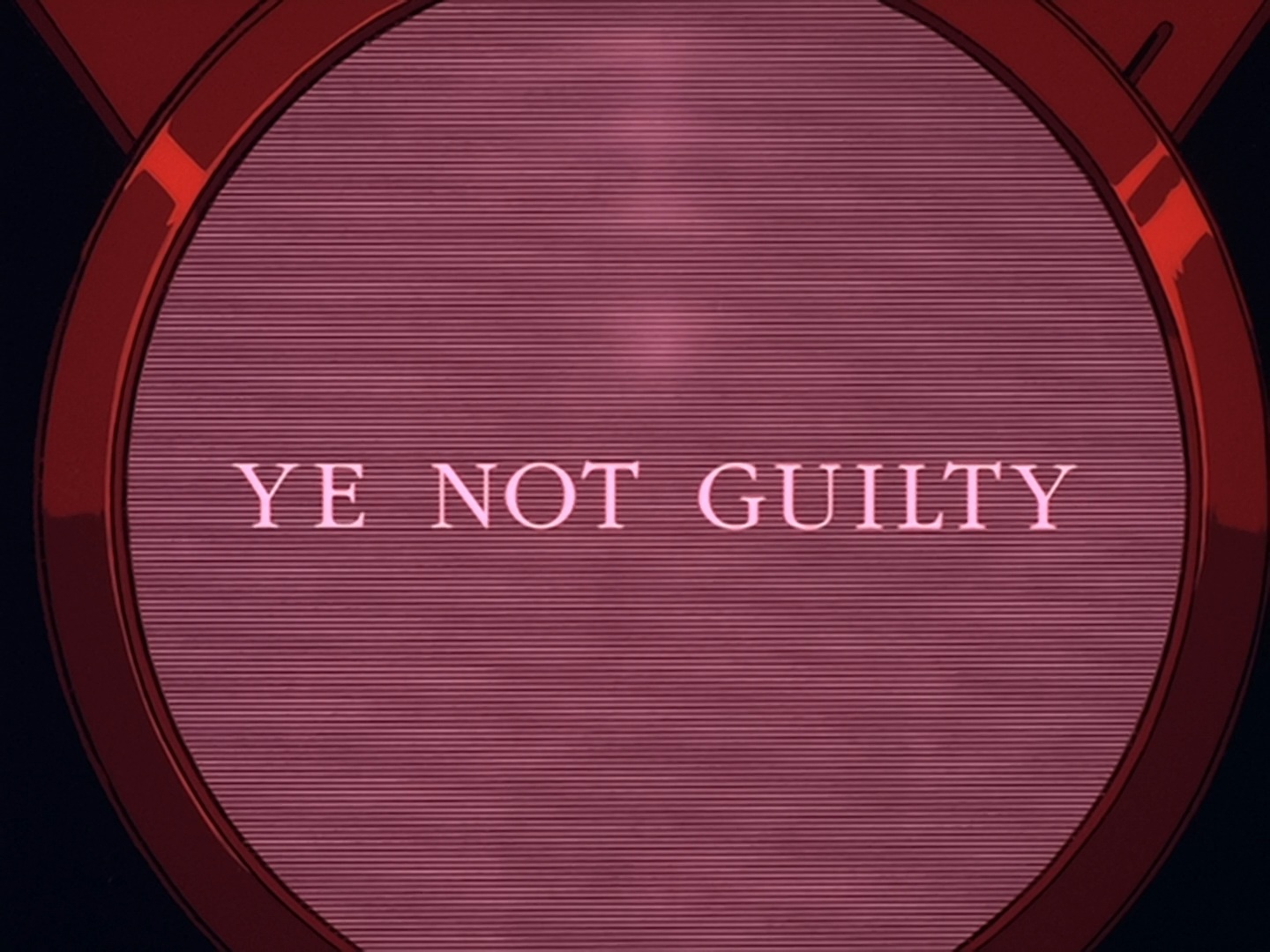
Video for reference: https://youtube.com/watch?v=iBEvITqye3Q
"Come with me now, Nyaruko... Until the edge of the galaxy!" (14:30)
The Japanese line is "Issho ni ikou, Nyaruko. Ginga no hate made" (一緒に行こうニャル子、銀河の果てまで). This is referencing a line said by Ranka Lee in episode 12 of "Macross Frontier" (マクロスF), an anime series that aired in 2008. Her line goes, "Minna! Dakishimete! Ginga no hate made!" (みんな!抱きしめて!銀河の果てまで!), which translates to "Everyone! Hold me! Until the edge of the galaxy!".
"You could call him my darling, bound to me by the red tentacle of fate." (14:48)
This is a reference to the red string of fate, an East Asian belief that destined lovers are connected by an invisible red string. It's similar to the notion of soul mates.
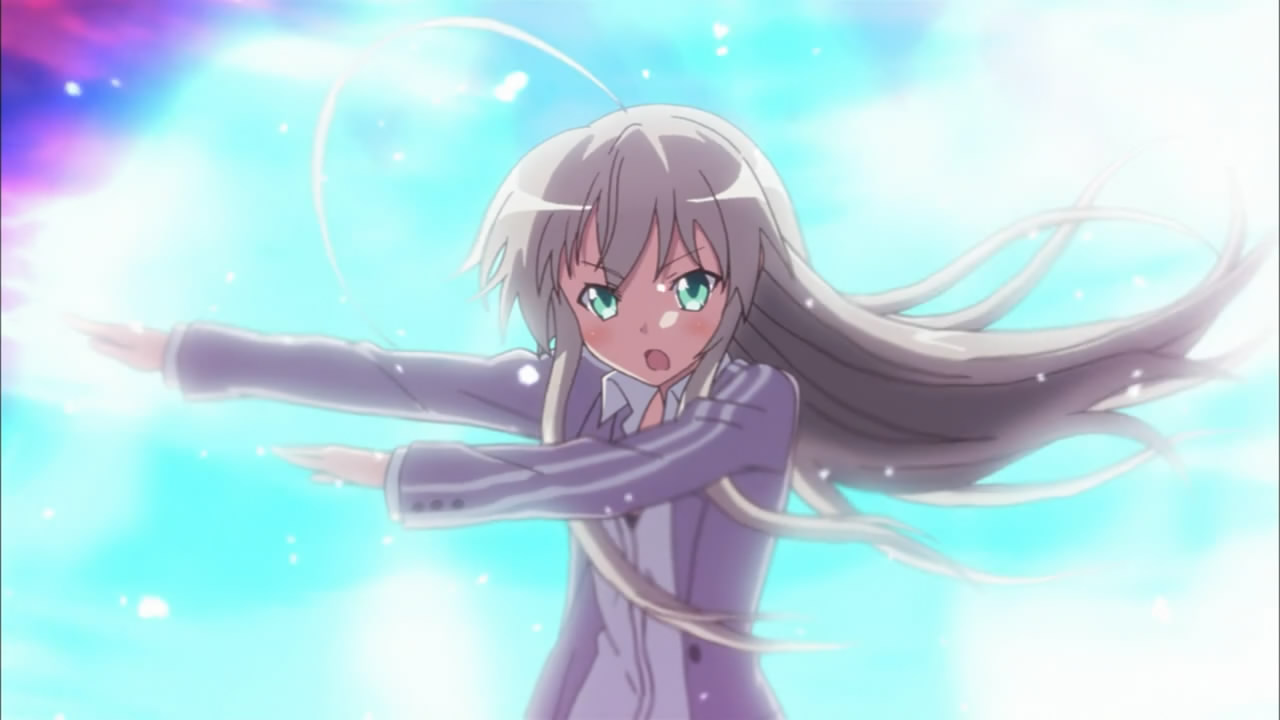
(15:39)
Nyaruko's poses are referencing those of Kamen Rider V3 from "Kamen Rider V3" (仮面ライダーV3), a Japanese TV show about a masked super hero that aired from 1973 to 1974.S7 Images for reference:

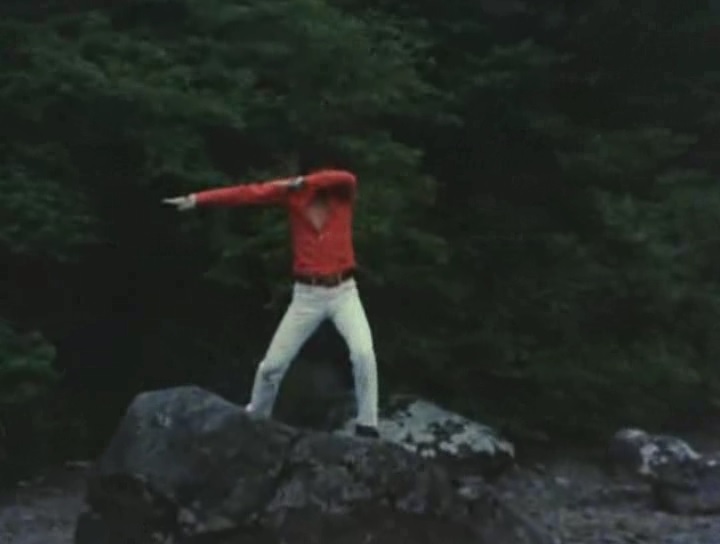
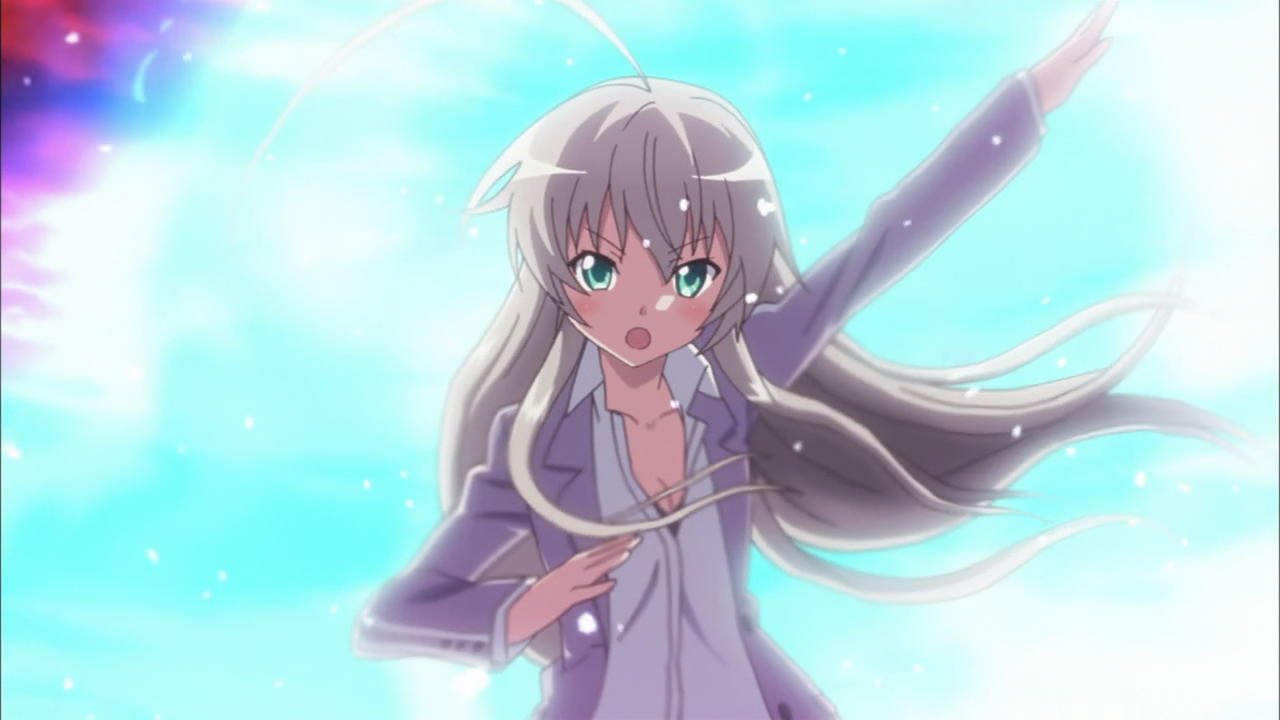
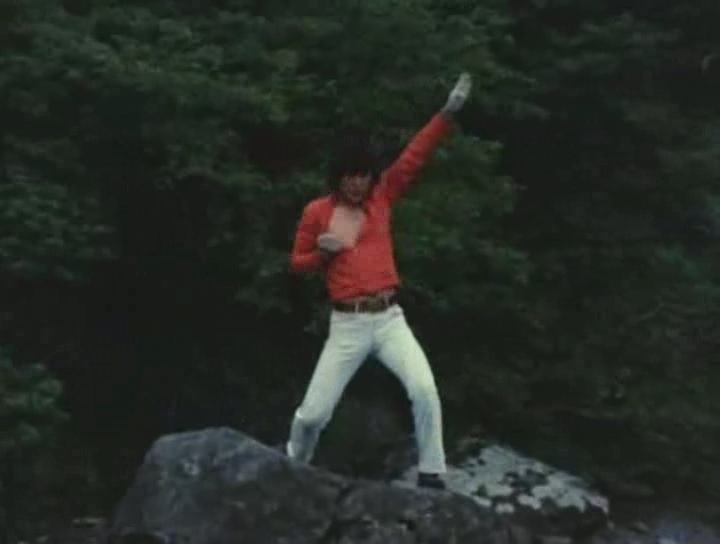
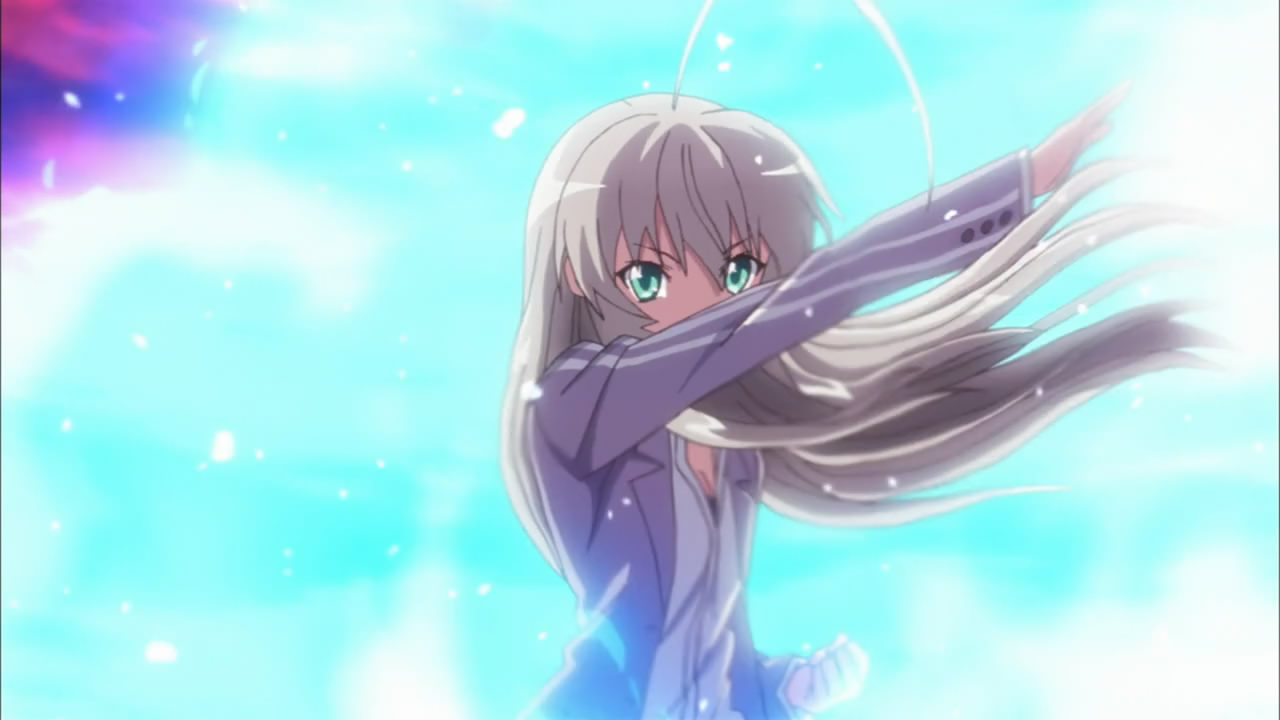
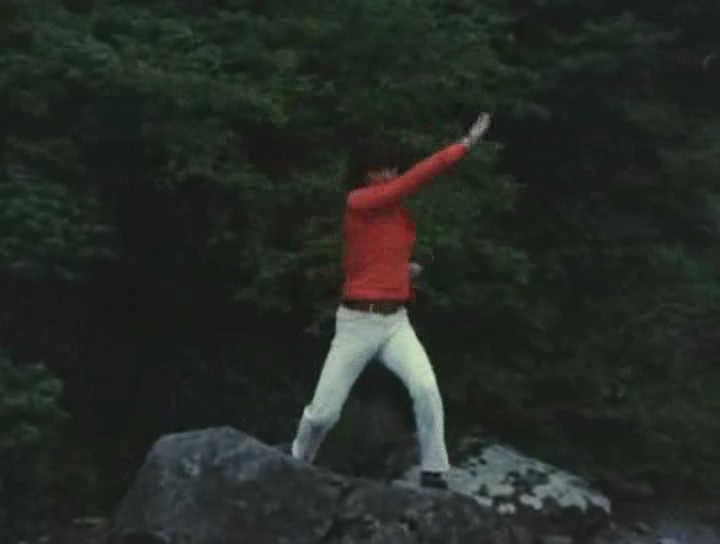

(15:53)
Nyaruko's outfit includes the famous Rider henshin belt and has wrinkles on her suit to mimic the appearance of the material used to make the real Rider suits.S7
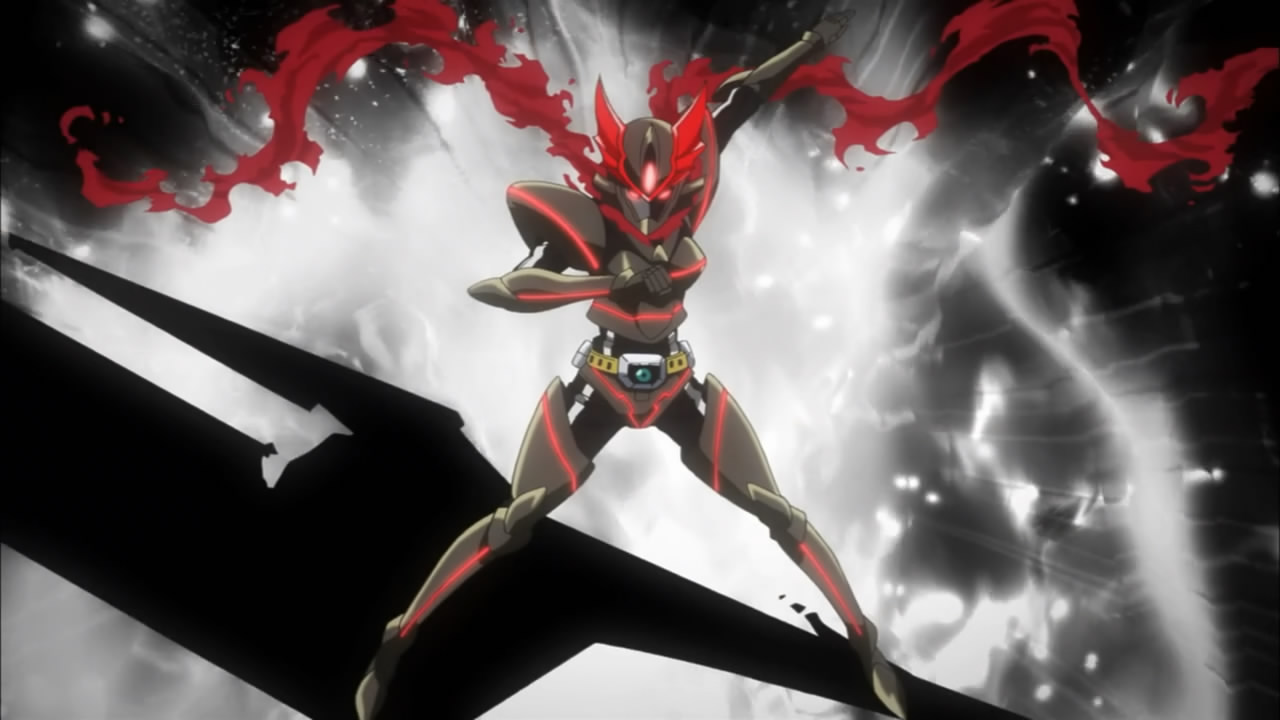
(15:59)
Nyaruko's costume is based on Knight Blazer (ナイトブレイザー) from "WILD ARMS 2nd IGNITION" (ワイルドアームズ セカンドイグニッション), a video game released by Media.Vision (メディア・ビジョン) in 1999.S3 Image for reference:

Source of image: https://www.amazon.co.jp/dp/B007T3VGTU
As stated in a tweet by Aisora Manta (逢空万太), the author of "Haiyore! Nyaruko-san",
~< `・ω・´> 何度も言ってますがニャル子のフルフォースフォームはナイトブレイザーがモチーフですからね。つまりこれよりさらに……あとは分かるな?The term "Furu Foosu Foomu" (フルフォースフォーム), "Full Force Form", is likely also referencing "WILD ARMS 2nd IGNITION" (ワイルドアームズ セカンドイグニッション).S10 In the game, characters have a parameter called "Foosu Pointo" (フォースポイント), "Force Point", and a character can have a maximum of 100 Force Points. Certain abilities require a certain number of Force Points to use. The main character, Ashley Winchester (アシュレー・ウィンチェスター), has an ability called "Access" (アクセス) which allows him to transform into Knight Blazer at the cost of 100 Force Points.
~< `・ω・´> I've said it many times but Nyaruko's Full Force Form has Knight Blazer as the motif. Basically from this furthermore...... you get the rest right?
On a related note, Aisora Manta made a tweet about Knight Blazer after the episode aired.S3 His tweet goes as follows:
~< `・Д・´> おいみんな! AmazonでD-Artsナイトブレイザーの予約始まってるぞ!
~< `・Д・´> Yo everyone! Pre-orders for D-Arts' Knight Blazer at Amazon have started!
(16:03)
The line at this time goes as follows:
「あんたの敗因はたった一つ・・・たった一つのシンプルな答えだ・・・あんたは・・・あんたは私を怒らせた!」This is referencing a line said by Kuujou Joutarou (空条承太郎) in chapter 264 in volume 28 of "Jojo no Kimyou na Bouken" (ジョジョの奇妙な冒険), "Jojo's Bizarre Adventure", a manga series written by Araki Hirohiko (荒木飛呂彦) and published starting from 1987.S1 His original line goes as follows:
"Anta no haiin ha tatta hitotsu... Tatta hitotsu no shinpuru na kotae da... Anta ha... Anta ha watashi wo okoraseta!"
"There is just one reason for your defeat... Just one simple reason... It's because... It's because you pissed me off!"
「てめーの敗因は・・・たったひとつだぜ・・・DIO・・・たったひとつの単純な答えだ・・・・・・『てめーはおれを怒らせた』」Images for reference:
"Temee no haiin ha... tatta hitotsu da ze... DIO... Tatta hitotsu no shinpuru na kotae da... 'Temee ha ore wo okoraseta'"
"There is just one reason... for your defeat... Dio... Just one simple reason...... 'You pissed me off'"
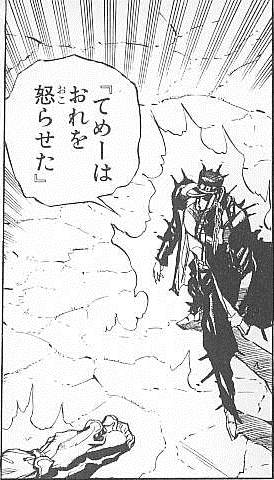
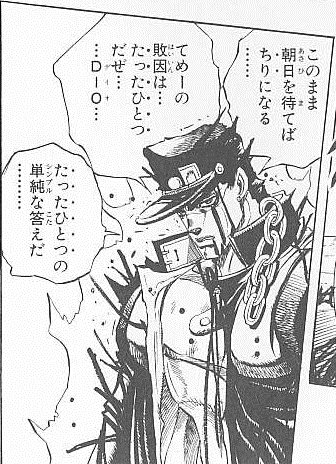
(16:25)
A this time Nyaruko repeatedly says, "Muda" (無駄), which translates to "useless" or "futile". This is referencing the same line often said by Dio Brando (ディオ・ブランドー) in "Jojo no Kimyou na Bouken" (ジョジョの奇妙な冒険), "Jojo's Bizarre Adventure". Image for reference:
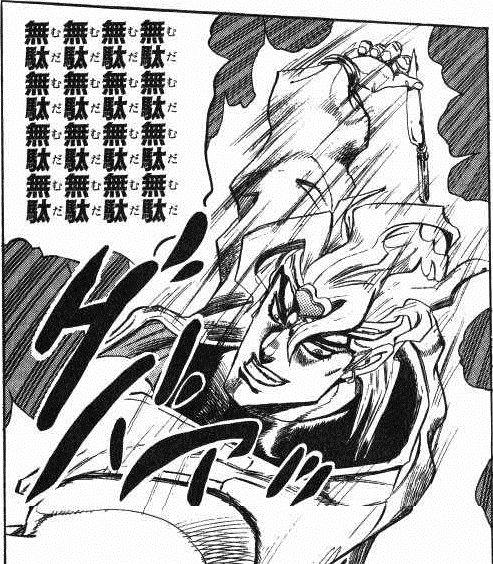

(16:32)
Cthuko lying face down is referencing Matsuoka Miu (松岡美羽) from "Ichigo Mashimaro" (苺ましまろ), "Strawberry Marshmallow", a manga series written by Barasui (ばらスィー) and published starting from 2001. As a running gag, Miu often ends up lying face down on the floor as a result of tripping or getting hit by someone after aggravating them.S1 Image reference:
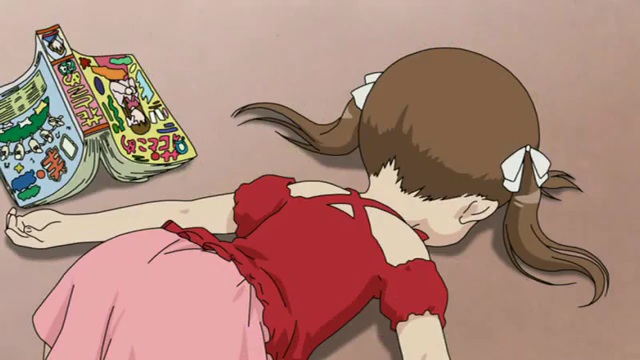
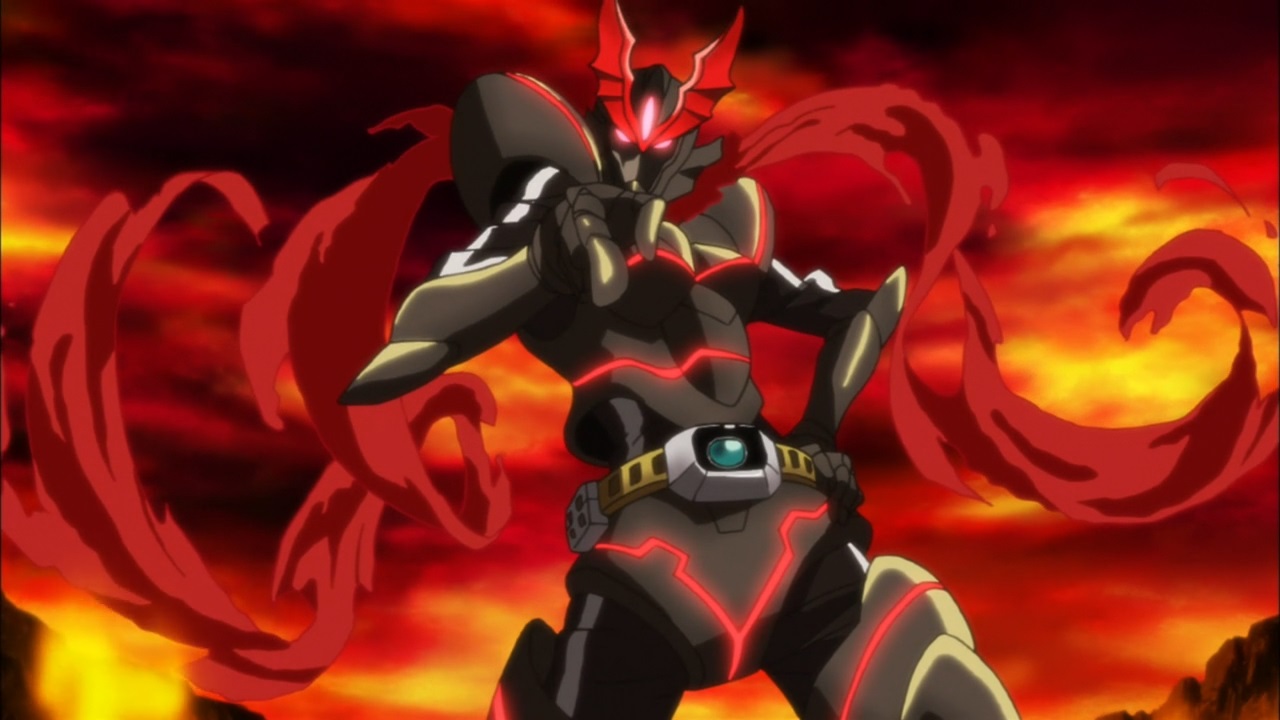
"Good grief." (16:37)
The Japanese line is "Yare yare daze" (やれやれだぜ). This is the catch phrase of Kuujou Joutarou (空条承太郎) in "Jojo no Kimyou na Bouken" (ジョジョの奇妙な冒険), "Jojo's Bizarre Adventure". Image for reference:
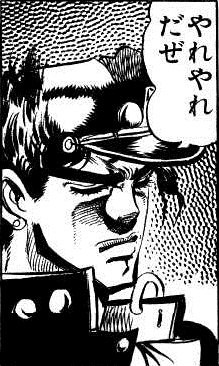
Nyaruko's pose is also mimicking Joutarou. Image for reference:
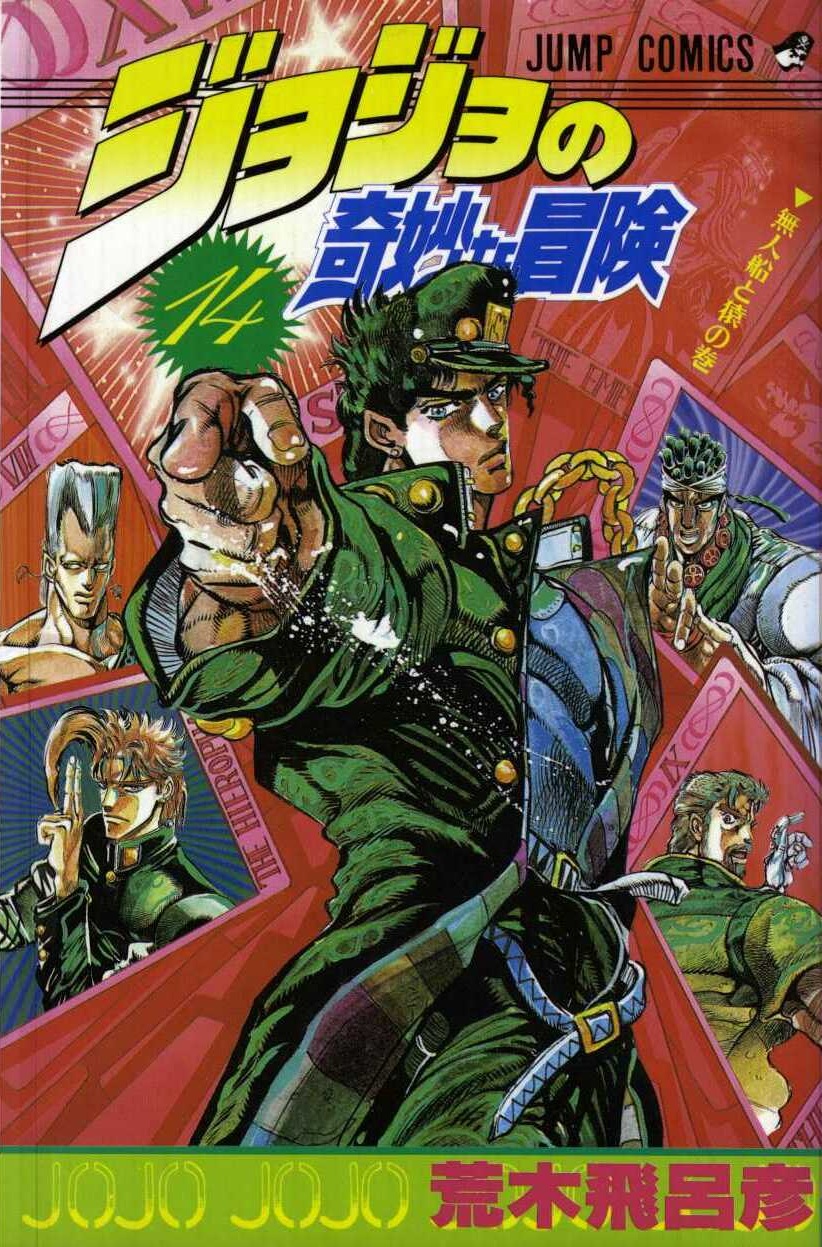
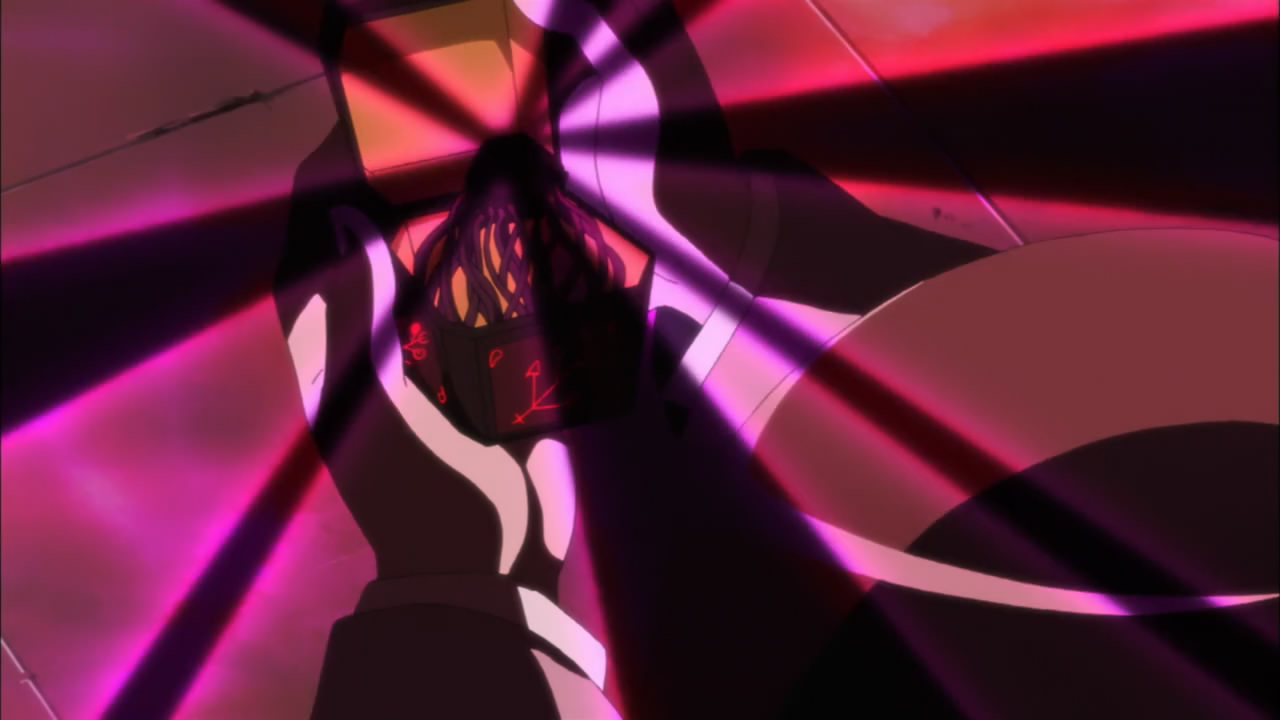
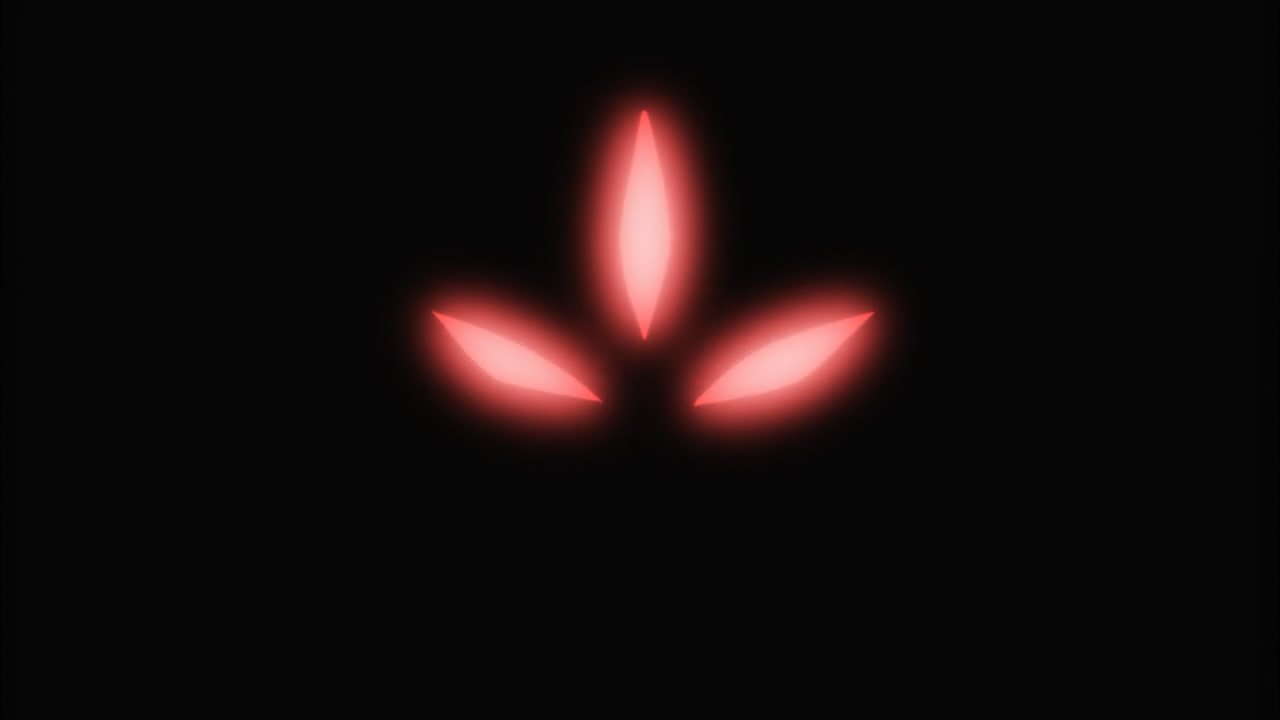
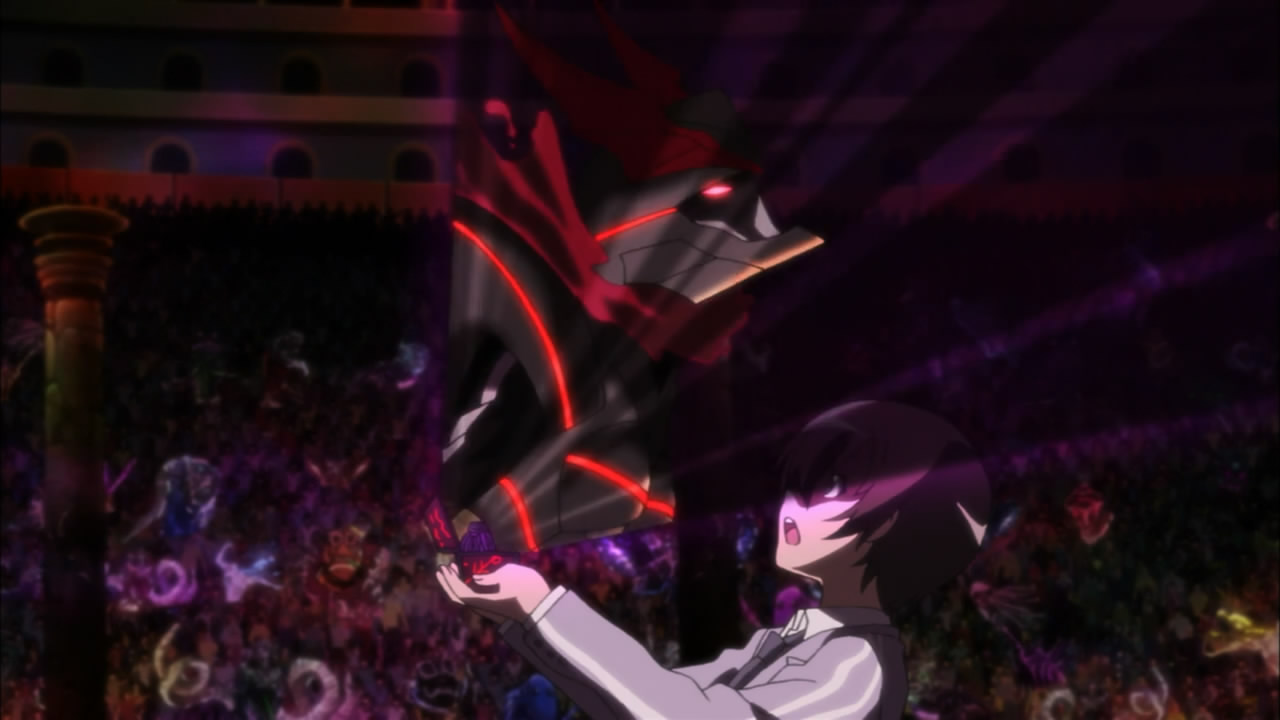
(16:54)
The box that Nyaruko gave to Mahiro earlier in the episode contains the Shining Trapezohedron, a mystical crystal that is described as being "a window on all time and space" and first appeared in "The Haunter of the Dark", a story written by H. P. Lovecraft and first published in 1936. By staring into the Shining Trapezohedron, the onlooker summons the Haunter of the Dark, an avatar of Nyarlathotep described as having a burning tri-lobed eye. The scene above directly references the Trapezohedron's abilities and usage, and the design of Nyaruko's helmet references the appearance of Nyarlathotep when summoned through the Shining Trapezohedron.
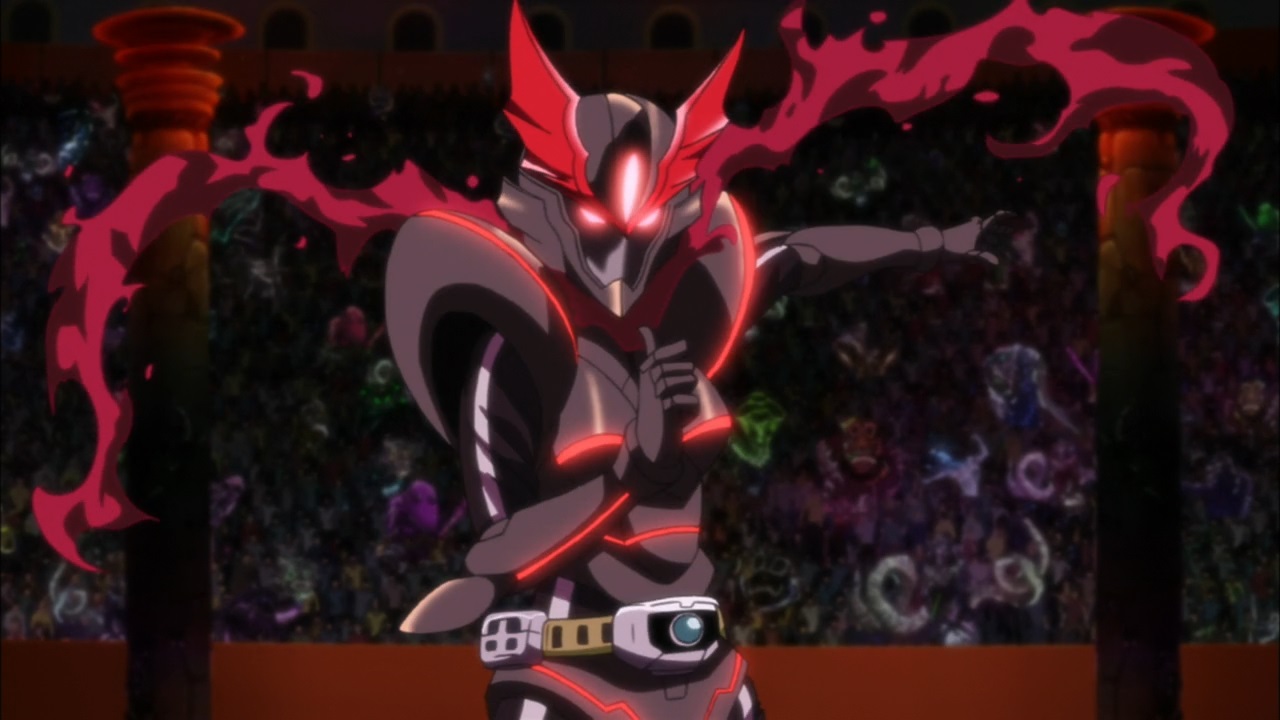
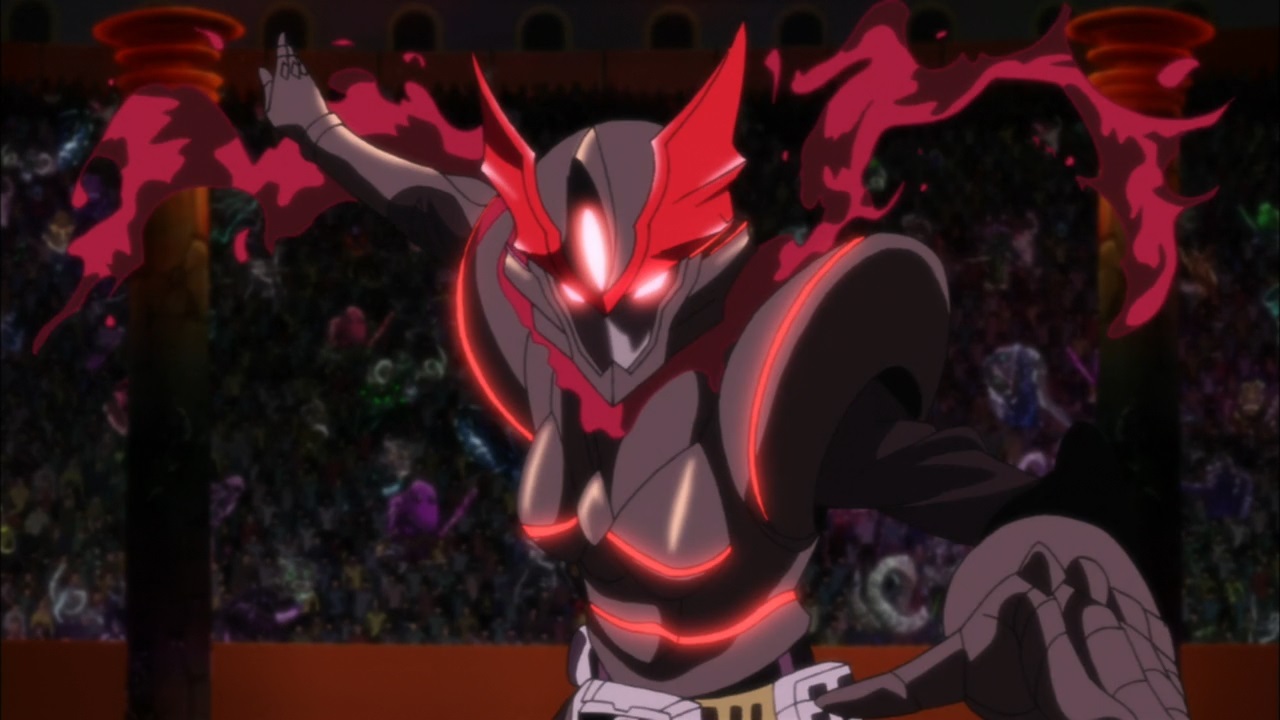
"I have arrived." (17:04)
The Japanese line is "Watashi sanjou!" (私参上!). This referencing the catchphrase of Momotarosu (モモタロス) from "Kamen Rider Den-O" (仮面ライダー電王), a Japanese TV show about a masked super hero that aired from 2007 to 2008. His original line goes, "Ore sanjou!" (俺参上!), which has the same meaning as above. Nyaruko's poses are also mimicking Momotarosu when he says his catch phrase.S7 Images for reference:
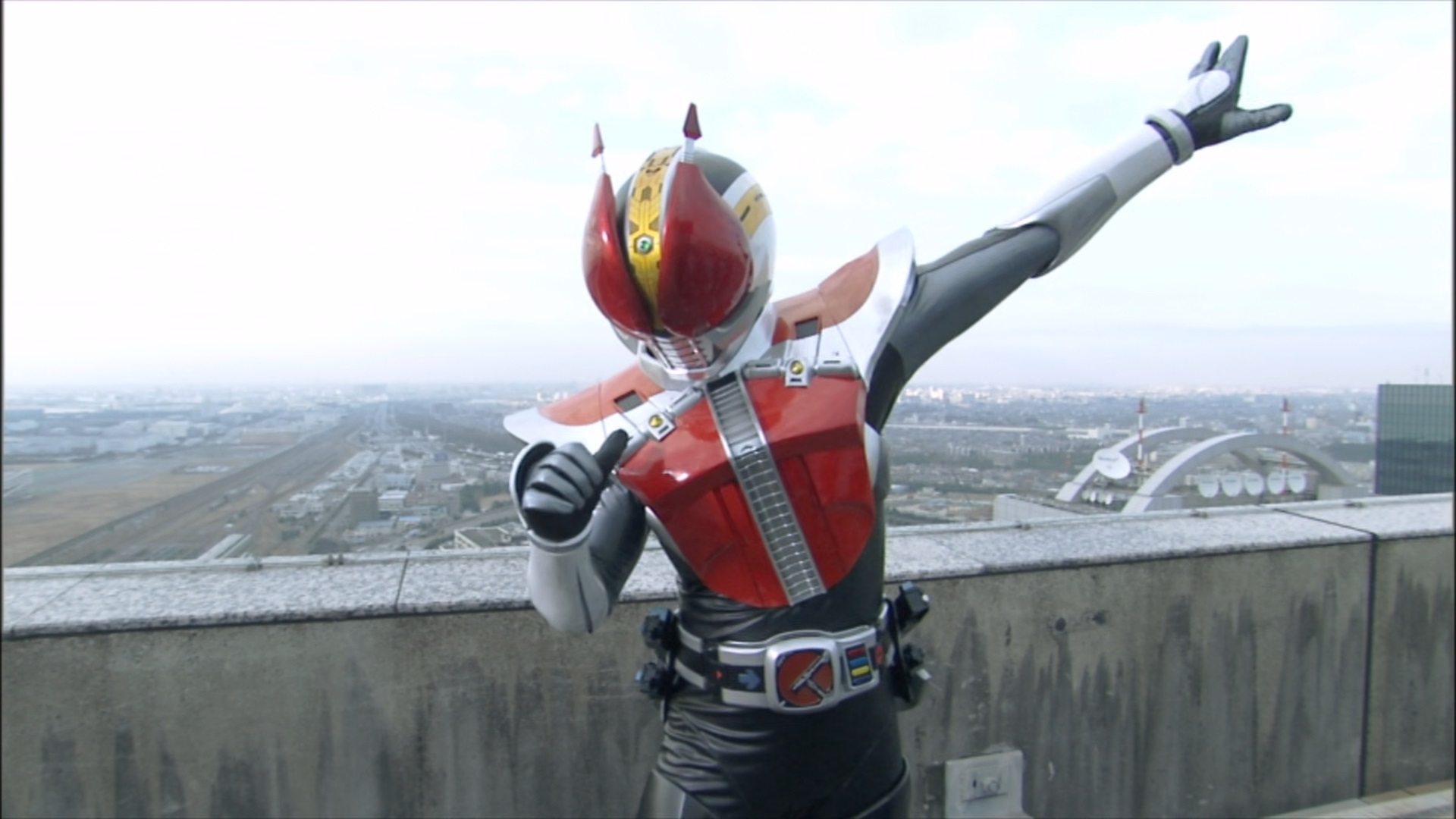
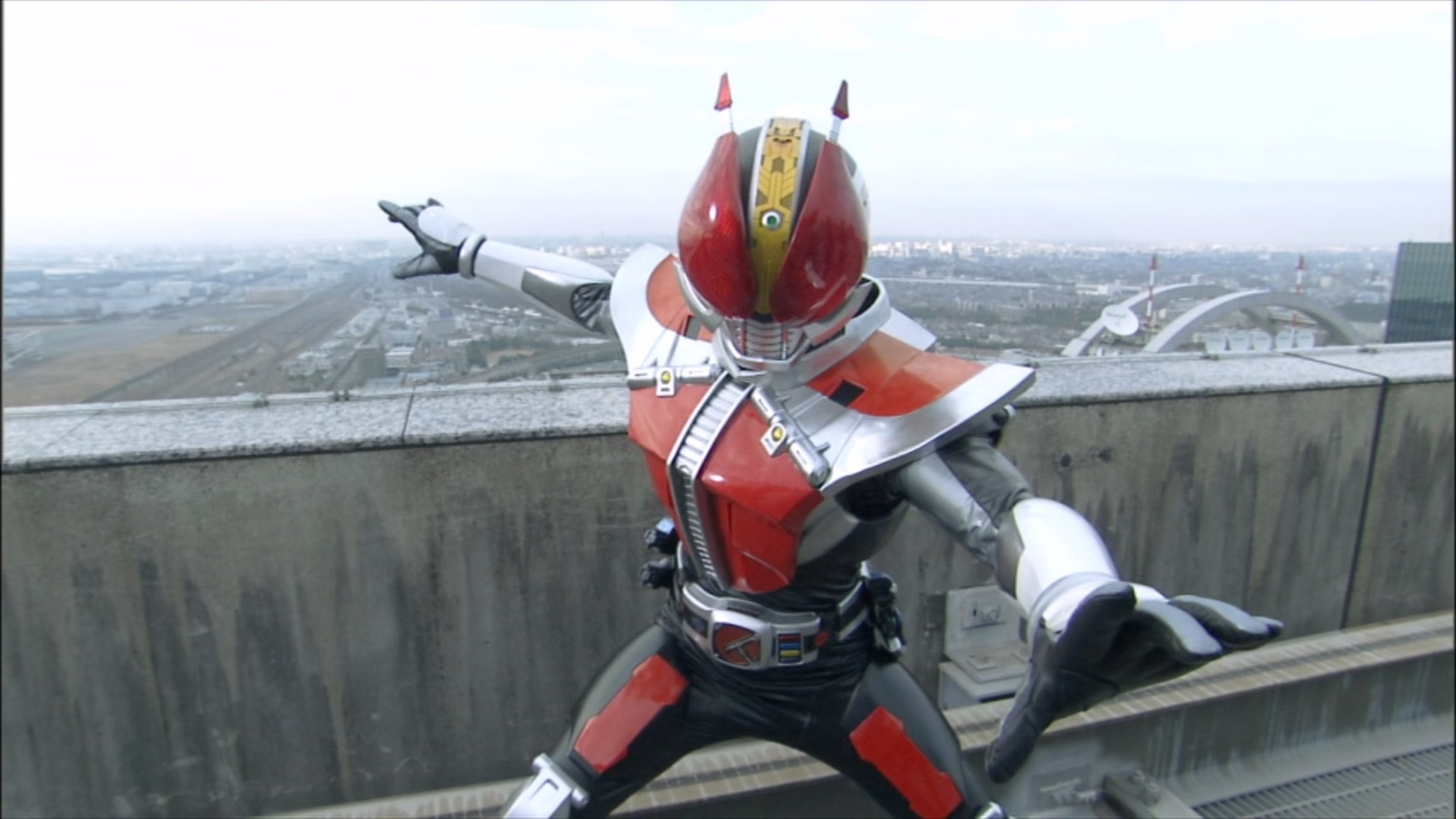
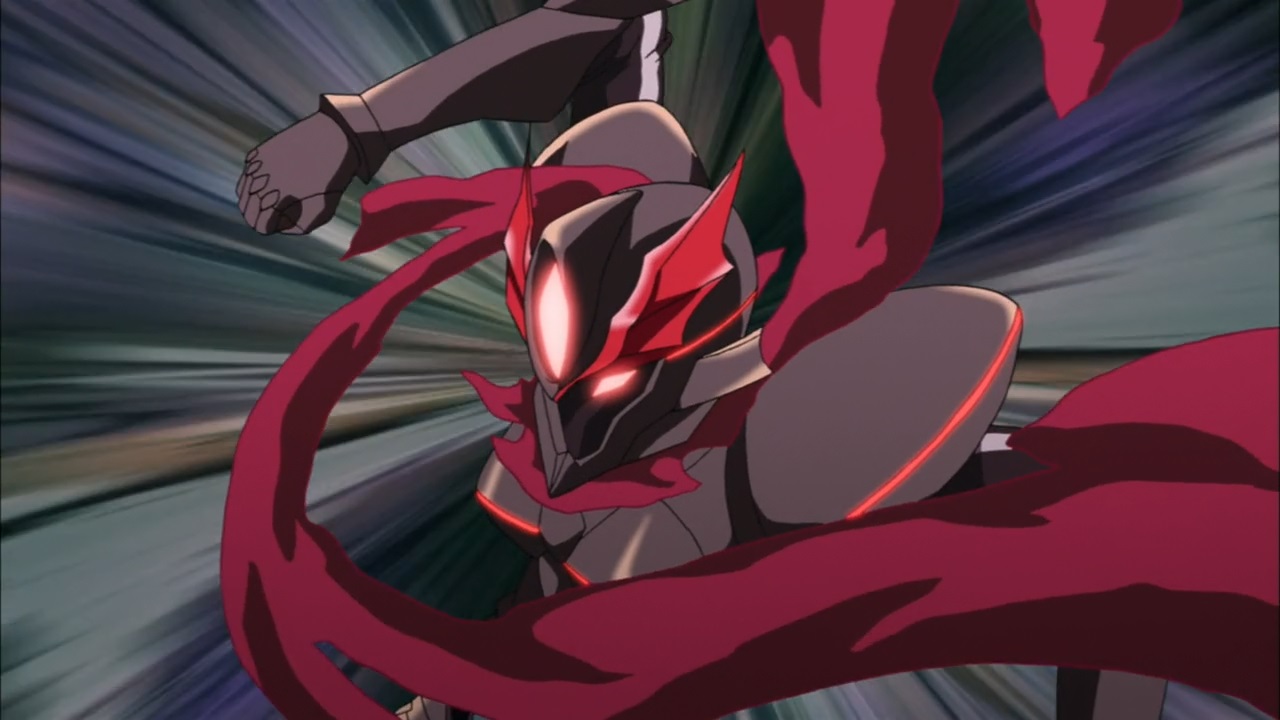
"Exterminating Last Bullet!" (18:52)
The Japanese line is "Massatsu no Rasuto Buritto" (抹殺のラストブリット). This is the name of a special attack used by Kazuma (カズマ) in "s.CRY.ed" (スクライド), an anime series that aired in 2001. Nyaruko's attacking motion is also mimicking Kazuma when he uses this attack. Image for reference:
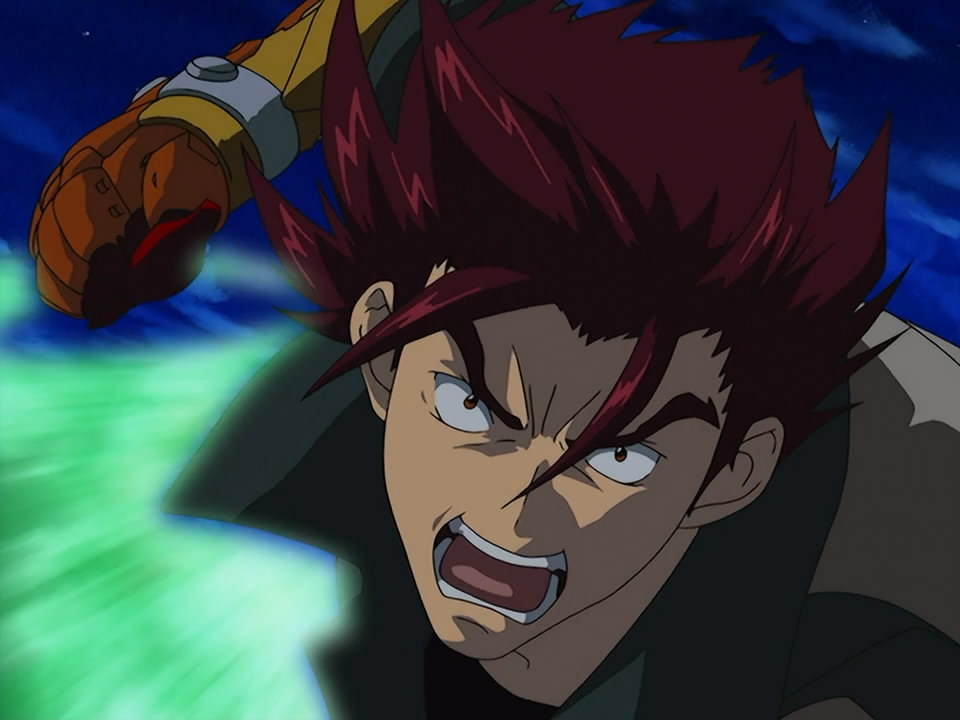
On a related note, the person who wrote the script for episode 2 of "Haiyore! Nyaruko-san", Hyoudou Kazuho (兵頭一歩), also wrote a series of light novels based on "s.CRY.ed" that were published from 2002 to 2012.S1

(19:56)
The tower in the background is based on the West Tokyo Sky Tower (西東京スカイタワー), also known as Tanashi Tower (田無タワー).S3 Picture for reference:
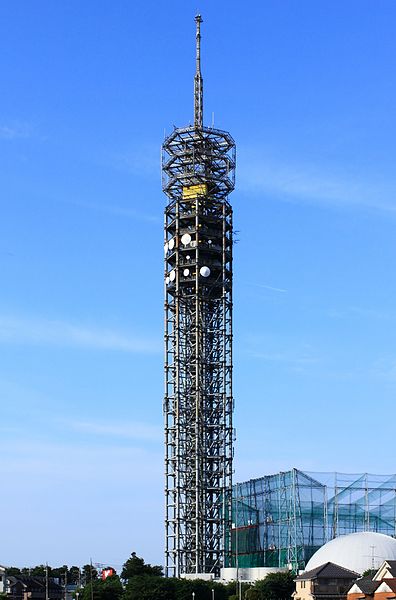
Source of image: https://ja.wikipedia.org/wiki/ファイル:SkyTower_NishiTokyo.JPG
"Would you like to start with me? Or would you prefer me first? Or maybe you'd like... me?" (21:08)
The Japanese line is "Mazu ha watashi ni shimasu? Sore tomo watashi ga ii desu ka? Hyotto shite Wa Ta Shi?" (まずは私にします?それとも私がいいですか?ひょっとしてワ・タ・シ?). This is parodying a cliched line in Japanese culture that a wife asks to her husband that has just returned home from work.S4 The usual line is "Gohan ni shimasu? Ofuro ni shimasu? Sore tomo Wa Ta Shi?" (ご飯にします?お風呂にします?それともワ・タ・シ?), or "Would you like dinner? Would you like to take a bath? Or would you like... me?".
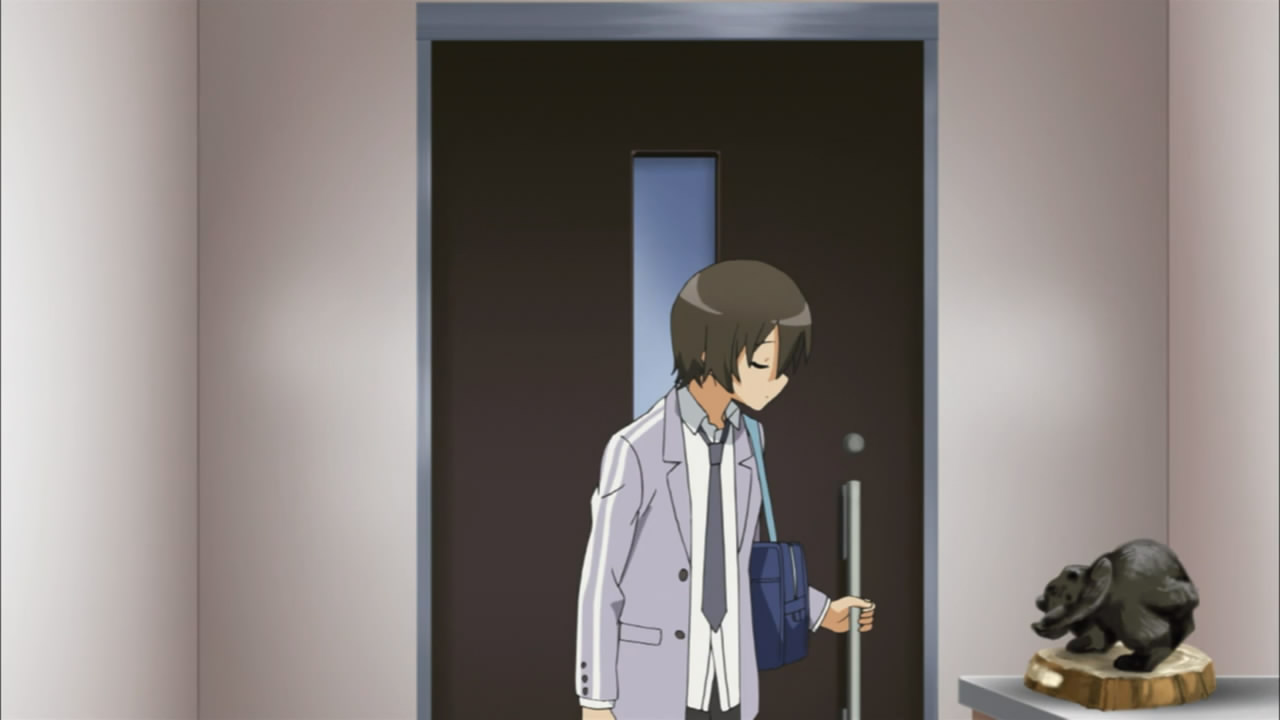
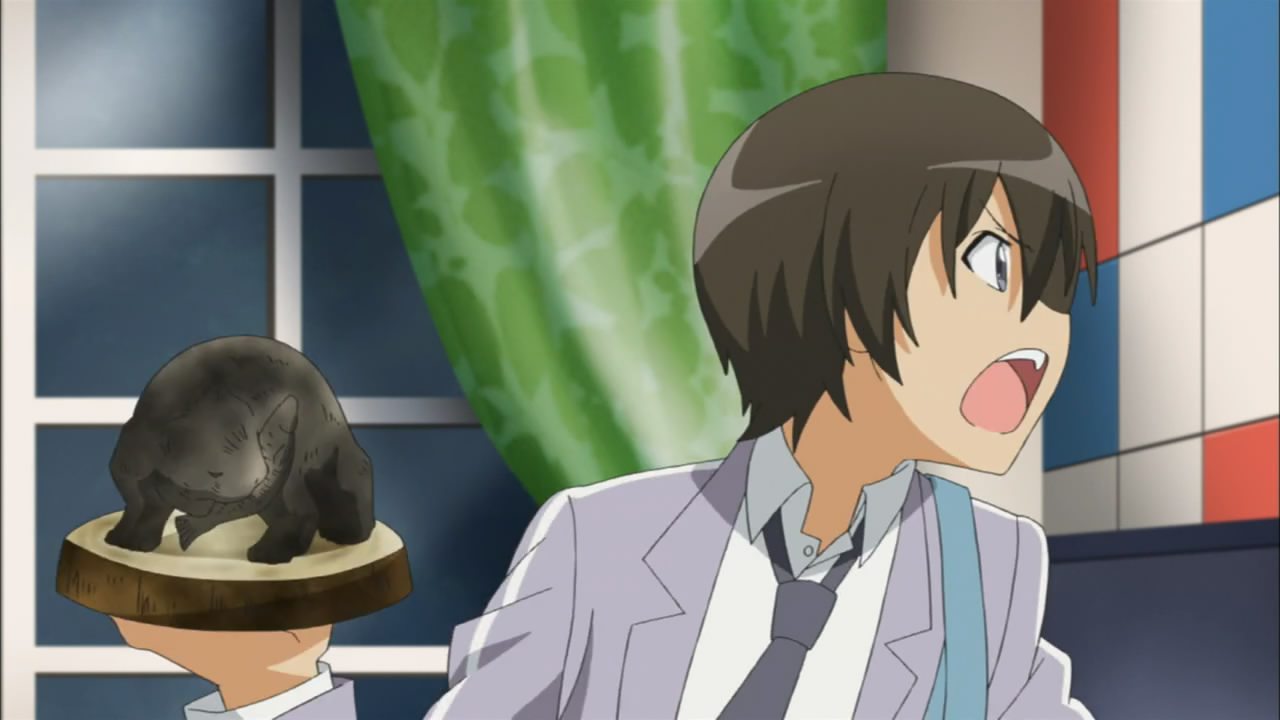
(21:02), (21:18)
The small statue is of a bear with a salmon in its mouth. It is known as a "kibori no kuma" (木彫りの熊), "carved wooden bear", and is a famous souvenir from Hokkaido. On a related note, the author of the "Haiyore! Nyaruko-san" light novel series, Aisora Manta (逢空万太), was born in Sapporo, Hokkaido. Image for reference:
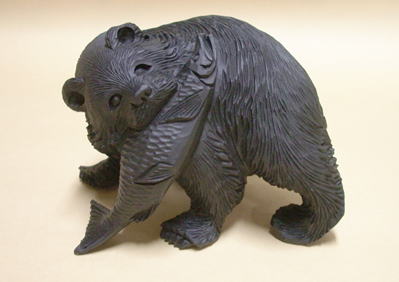
Source of image: http://yogozansu.cocolog-nifty.com/blog/2007/08/post_374a.html
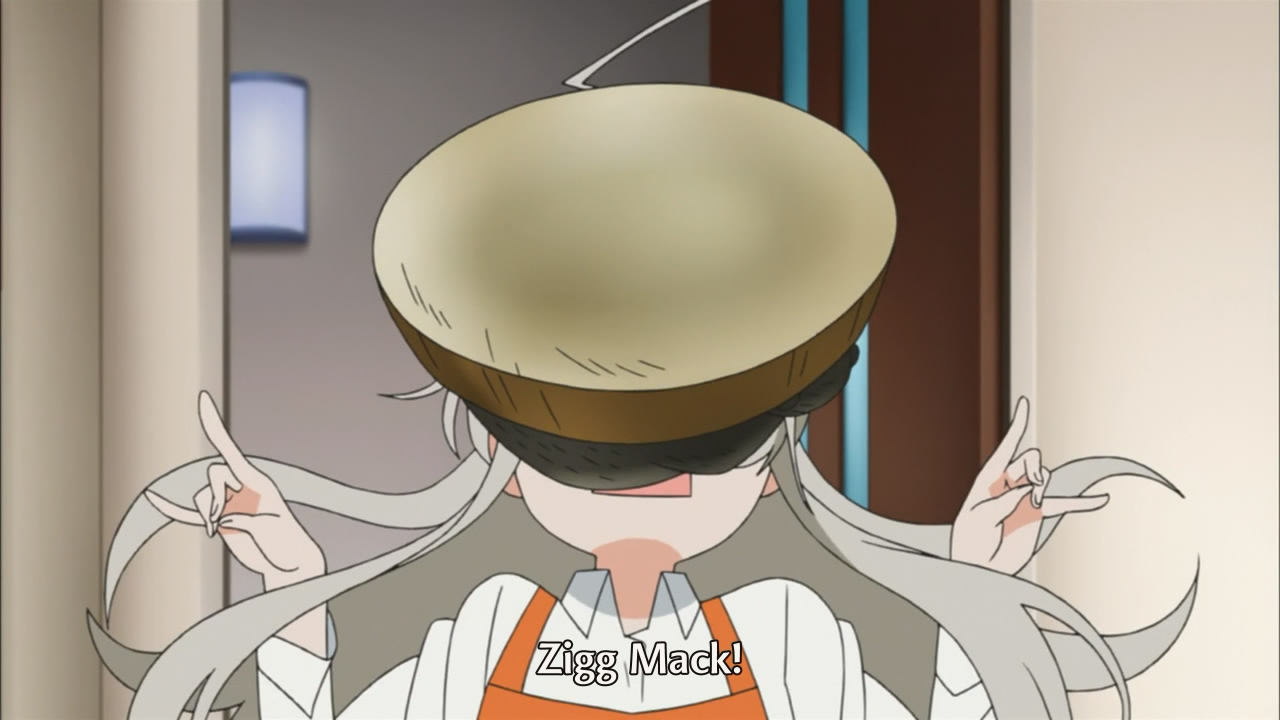
"Zigg Mack!" (21:21)
There are two references here:
* The second of Nyaruko's yelps this episode. Zigg Mack (ジグ・マック) is the name of a combat vehicle from "Space Runaway Ideon" (伝説巨神イデオン).S8
* Nyaruko's pose is referencing a gag pose that is often used in manga series written by Takahashi Rumiko (高橋留美子), such as "Urusei Yatsura" (うる星やつら) and "Inuyasha" (犬夜叉).S3 Image for reference:
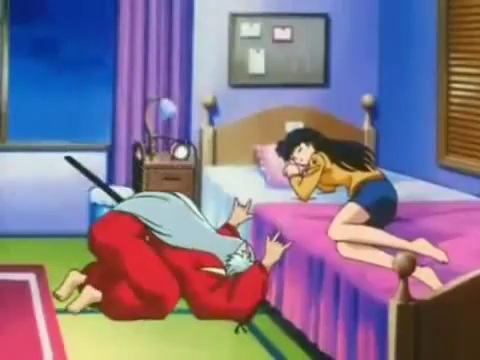
"I want enough children to form an entire soccer team. Could this be a real life 'Let's Make Babies! Touch & Direct!' kind of thing?" (21:50)
This is referencing "Saka Tsuku DS Touch & Direct" (サカつくDS タッチandダイレクト), "Make Soccer DS Touch & Direct", a video game released by SEGA (セガ) in 2008. This game is a part of "Puro Sakka Kurabu wo Tsukurou!" (プロサッカークラブをつくろう!), "Let's Make a Pro Soccer Club!", a series of video games released starting from 1996.S5
"Gando Rowa!" (22:06)
The last of of Nyaruko's yelps this episode. Gando Rowa (ガンド・ロワ) is the name of a spacecraft from "Space Runaway Ideon" (伝説巨神イデオン).S8
"The title is 'Our-'" (23:46)
"It's some sort of H.P. Lovecraft joke, right?"
The Japanese line is "Taitoru ha 'Futari E-'" (タイトルは「ふたりエ」). What Nyaruko was about to say before Mahiro interrupts is "Futari Ecchi" (ふたりエッチ), a manga series written by Katsu Aki (克・亜樹) and published starting from 1997.S1 Also, "ecchi" (エッチ) is a Japanese pronunciation of the letter "H", which ties into Mahiro's line about how Nyaruko was going to make a joke about H. P. Lovecraft, the author whose works led to the creation of the Cthulhu Mythos that "Haiyore! Nyaruko-san" is based on.
List of sources:
S1. Japanese Nyaruko References Wiki (這いよれ! ニャル子さん 元ネタwiki) - Nyaruko Episode 2
S2. Japanese Nyaruko References Wiki (這いよれ! ニャル子さん 元ネタwiki) - Nyaruko Light Novel Series Volume 4, Chapter 4
S3. A post at Steman Blog (ステマブログ)
S4. A post by convexity
S5. Comments in Commie Subs' subtitle file
S6. A video posted by nicovideo user Taniiwa (タニーワ)
S7. A post by the reddit user MintySocks
S8. A post by the reddit user RoyalGuard128
S9. A post by the reddit user anabis
S10. Comments on this post
S11. A blog by servitors about Cthulhu Mythos inspired works (クトゥルー/クトゥルフ神話作品発掘記)
Thanks to everyone who contributed! This list wouldn't be nearly as long without you all. See you next episode!
情報を教えてくださって本当にありがとうございました!皆さんがいなかったら、このリストはぜんぜん長くありません。またこの次までね!
Last updated April 23, 2013
Sitemap
Home
